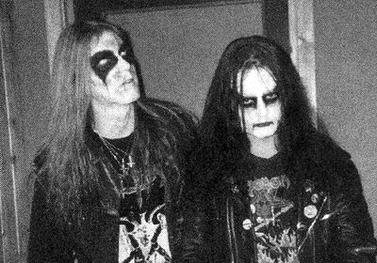
Prologue: What is this that stands before me?
THE DEVIL’S CULTURE is real. Satan, darkness, sex, blood, violence, witchcraft, the unknown. It was always there. From Jacques Tourneur’s “Night of the Demon” to the Hammer Horror films and Dario Argento’s “Suspiria”.
From Tony Iommi’s “devil’s chord” (the tritone) to Mercyful Fate’s early satanic metal and King Diamond, the follower of Anton LaVey, bald-headed & goat-bearded founder of the Church of Satan and author of The Satanic Bible.
From the inverted cross in Black Sabbath’s debut album and Venom’s goat album covers to Bathory’s “In Conspiracy with Satan” and Watain’s “Storm of the Antichrist”, up to Deicide’s satanic death metal and The Devil’s Blood occult retro rock, the Devil’s culture was always here. True or part of an act, it is real in art and life.
It is widely known that Black Metal (the genre) was named after the second Venom studio album, originally released in 1982. However, during ’80s and the first wave of black metal, such terms were abstract and general, and took a few years until they shaped a certain form to characterize a subgenre of metal music.
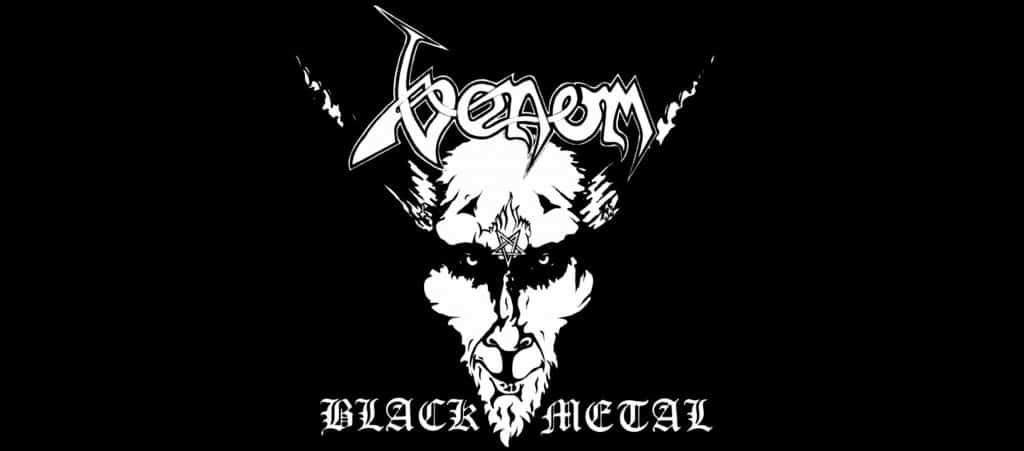
Heavy metal was formed as a rebellious music, a genre born in freedom, revolution, escapism and youthful energy. {At least in the beginning.} Black metal was born alike but raised and shaped differently. Black metal is the most extreme aspect of metal music and extremity often leads to the edge.
And when you’re balancing on the edge, sometimes the “part of an act” is not far away from the abyss, blood, extreme ideas, even the end of life. Especially when you dive deeper and get connected with things that for others are just escapism.
After all, many times, the better music is when the artists express their feelings, and in black metal, sometimes those feelings are as extreme as the music.
Back in the ’80s, heavy metal was also described as “Satan’s music” and people were searching for backmasking (a message recorded backwards onto a track that is meant to be played forward) in the records of Ozzy Osbourne and Judas Priest.
But while they were searching for backward messages, the message of evil was already there. After all, The Louvin Brothers warned us since 1959 with “Satan Is Real” when they said: “You can hear him in songs that give praise to idols and sinful things of this world. You can see him…”
From The Rolling Stones’ “Sympathy for the Devil” to Coven’s “Satanic Mass” it’s just a one-year period, so it is very easy to understand what would happen many years later…
Written by Andreas Andreou (September – December 2020)
Part I: Shaping the Void – The First Wave of Black Metal (the ’80s)
From the Church Hall rehearsals to the £50 demo recordings at the Impulse Studio, little did Venom know what would happen when they finally managed to release their first 7″ single with “In League With Satan” and “Live like an Angel (Die like a Devil)” covered with THAT sleeve.
Clive “Jesus Christ” Archer, the first singer of Venom during 1979-1980, is the first case of a band member using corpse painting but he was lost in the depths of Hell and it was later when King Diamond used his iconic “Gene Simmons-lawsuit-threatened” make-up in Mercyful Fate, establishing a major influence for the second wave of black metal.
The image of the classic 3-piece Venom line-up of Cronos, Mantas and Abaddon also influenced a major part of the next (and current then) extreme metal generation including also Quorthon of Bathory.
Furthermore, the early rites of the unholy trinity from Newcastle UK, named other important bands that helped shaping the sound of black metal, including Sodom (from the song “One Thousand Days in Sodom”) and Mayhem (from the song “Mayhem with Mercy”).
Being part of the New Wave of British Heavy Metal movement, Venom separated their existence from the first moment into something else. “We never considered ourselves part of the NWOBHM”, Anthony “Abaddon” Bray told me once and Venom wanted to shock the world, bringing something extreme and original to the music scene. Adopting stage names was also something influential, let alone the iconic album covers and the lyrics.
It is always debated when we’re talking about the birth of each genre and subgenre and most of the time, it is a combination of many things: bands and artists, songs, albums, events. But if we need to set one name as the genesis of each genre or subgenre, in the end it is not so difficult, but it will always be debated among fans (mainly) and music journalists (less).
So, if someone will make us mention just one name, when you’re having Black Sabbath as the starting point of heavy metal, then Venom is the starting point of black metal. In both cases though, each genre took its final form in the years to come, with a combination of more songs, albums and artists.
Back in the early ’80s, when metal music was shaping and evolving (or changing if you prefer) terms that were later used to characterize bands and sub-genres, were earlier used for bands and albums in lack of better terms or “words”.
So, you had adverts and record label promo sheets, even bands themselves sometimes, saying or writing that Venom and Slayer are “power metal”, Bathory is “death metal” and many more that nowadays sound wrong but in the context of that time, might be accurate since those “words” didn’t identify a genre at the time.
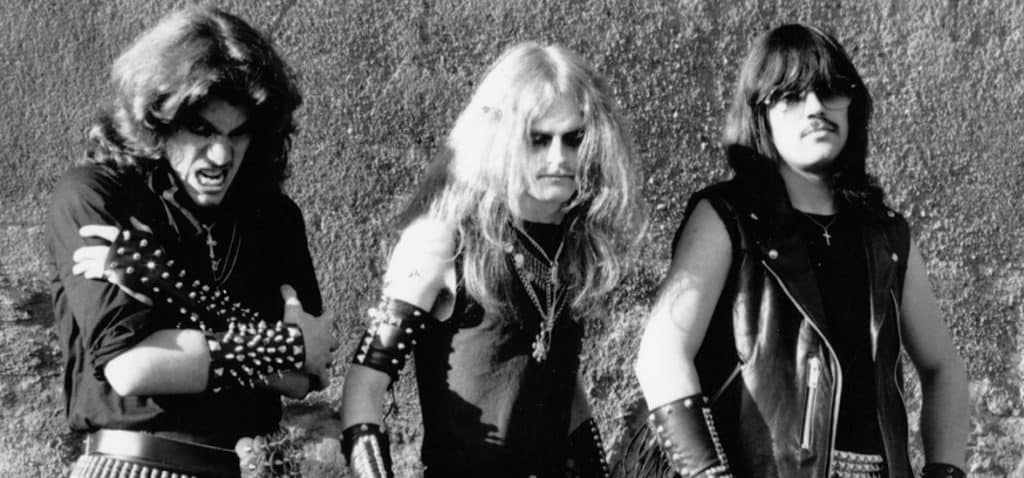
With that said, the first wave of black metal including Venom, Mercyful Fate, Sodom, Bathory, Hellhammer and Celtic Frost, all of them musically different to each other but with one common direction in their early albums: the Left-Hand Path, evil and darkness.
During the ’80s, Venom was the starting point followed by the rotten necrometal of Hellhammer & Celtic Frost and the imagery/lyrical content of Mercyful Fate.
Those were the early foundations of what became the most extreme subgenre of metal music but the massive influence and the key-point was the first three albums of Bathory, especially, “Under the Sign of the Black Mark” (1987), a template for the Norwegian black metal explosion in the early ’90s.
Starting as a band, it took no more than a few months for Quorthon (born Thomas Börje Forsberg) to continue as a one-man band keeping a mystical aura surrounding the true identity of Bathory.
Other notable mentions include the early works of Sodom from Germany. Sodom with “In the Sign of Evil” EP (1985) and “Obsessed by Cruelty” (1986) were heavily influenced by Venom and their “Deathlike Silence” track named Euronymous record label.
Thrash metal leaders Slayer also had a strong black metal vibe in their early albums, while Destruction with “Sentence of Death” EP (1984) and Possessed with “Seven Churches” (1985) also followed the Satanic concept and imagery with bullets, leather, inverted crosses and the sound that led to black thrash and death metal. But those later-established-thrash bands used those lyrics and imagery as part of their extreme music and not as true beliefs.
Adding influence to the genre, we also have to mention Death SS and Bulldozer, while a few other (traditional) metal bands in the ’80s that had any evil and satanic mention in a few of their songs, also influenced black metal in the later years.
A notable mention is early Manowar with songs like “Each Dawn I Die” (also covered by Necromantia) and “Bridge of Death”, including that opening riff that is black-metal-riffing before black-metal-riffing.
In the same year of 1984, the imagery, lyrics and aura of “Turn the Cross Upside Down” of the Finnish classic metallers Oz, also had a small share of influence (“Prince of darkness leads us all strike the Christians down”) and they also appeared on the “Scandiavian Metal Attack” split compilation along with Bathory.Adding further detail to the story, the hand that holds the skull on their album cover of “Fire in the Brain” (1983), belongs to Quorthon himself.
Darkness was spread in the farest sides of the world and certain bands-releases of the Brazilian label Cogumelo Records like Sarcofago with the iconic “I.N.R.I.” (1987) album, along with Mutilator and Vulcano, also set a stone in the pyramid that led to the second wave and the complete formation of black metal.
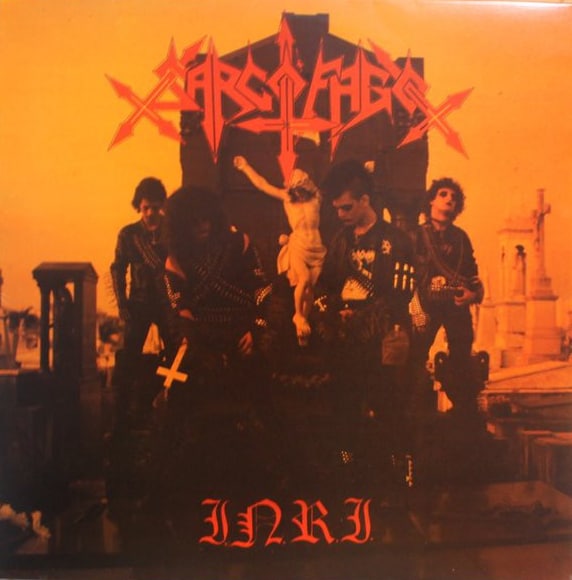
Many of those bands formed in the second half of the ’80s made an impact in the depths of underground with demo tapes and albums that were spread with letters and tape-trading to every side of the world, forming an underground community. Bands like Tormentor from Hungary, Mortuary Drape from Italy, Master’s Hammer and Root from Czechoslovakia, Samael from Switzerland and Mayhem from Norway…
Part II: The Grand Declaration of War
…releasing “Deathcrush” EP in 1987 with that pink cover on the first pressing, opposed to the Posercorpse imprint name (Mayhem’s independent label), everything sounded “wrong” and not only because of the cover on Venom’s “Witching Hour”.
The influence of the first wave of black metal is all over Mayhem’s “Deathcrush” and the result is an ugly, raw and brutal release filled with a violent and gore aesthetic. However, that lo-fi release, with all its mistakes and attempts to create something off the edge of normality, achieved its goal even if black metal is actually nothing like “Deathcrush”.
But that intense and extreme release that for some people is wrongfully labeled as “the beginning of Norwegian Black Metal”, it is actually the “mistake” that made Euronymous crush-death in the next few years and realize that (true) black metal will be something different.
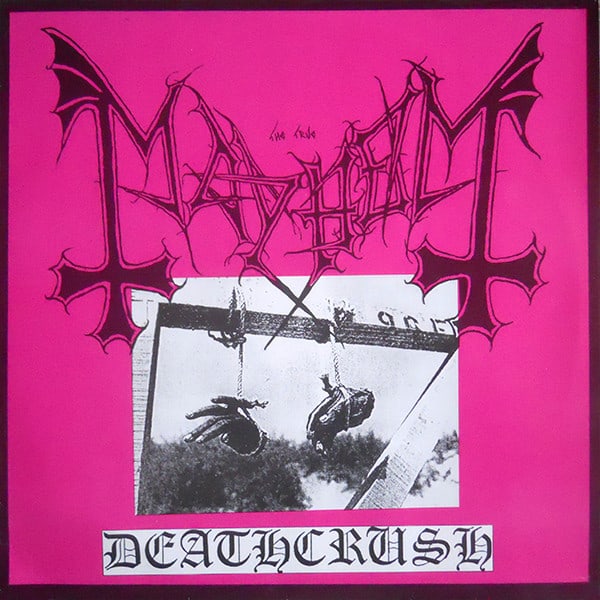
From the Possessed’s “Death Metal” demo of 1984 and Mantas’ “Death by Metal” demo of the same year, it was obvious that there was something deadly lurking in the underground metal scene. When Possessed finally released their “Seven Churches” debut album in 1985, another subgenre got its name: Death Metal.
Until the early ’90s, death metal became a genre that was close both to thrash and black metal. It was fast and brutal like thrash metal, and evil like black metal. Inspired by a few of the “first wave black metal bands”, the Possessed album, Death (the band) and Slayer’s “Reign in Blood”, it became a player in its own with bands like Morbid Angel, Deicide and Immolation.
However, its growing popularity and sales in the early ’90s, biggest labels that got an interest of the genre, high quality recording studios involved (like Morrisound in Florida), producers that shaped death metal (like Scott Burns) and a turn to more social and political lyrics (against evil and hatred), made Euronymous (born Øystein Aarseth), leader and guitarist of Mayhem, to declare war against Death Metal, the “life metal” bands as he used to say in.
Little did Warrel Dane know when he sang “so ends a decade now what will the nineties hold” in Sanctuary’s “Future Tense” of 1990, at least in Norway. Euronymous was a very influential person, a key-figure that spread underground extreme metal to every corner of the planet with letters, reaching contacts worldwide, even if he was in his early 20s, so after the “declaration of war” against death metal, musicians that were previously playing death metal changed.
Abbath Doom Occulta (born Olve Eikemo) and Demonaz Doom Occulta (born Harald Nævdal) that were previously in death metal bands like Old Funeral and Amputation formed Immortal. Kristian Vikernes, also of Old Funeral, formed his own black metal entity named Burzum, and Samoth (born Tomas Thormodsæter Haugen) with Ihsahn (born Vegard Sverre Tveitan) of death metallers Thou Shalt Suffer, formed Emperor.
Even Darkthrone who had just released their debut death metal album “Soulside Journey” in 1991, changed to black metal.
Tape trading most wanted rites: Morbid – December Moon (1987), Tormentor – Anno Domini (recorded in 1988 to be released as album, available as tape in 1989), Mortem – Slow Death (1989), Thorns – Grymyrk, The Trøndertun Tape(rehearsal and demo recorded in the early ’90s), Necromantia – Promo Tape 1990, Mayhem – Live in Leipzig (recorded in 1990, spread in 1991)
Part III: Helvete and the Inner Circle of Black Metal
In the summer of 1991, Euronymous opened the “Helvete” record store in Oslo and it also served as the headquarters of his record label, Deathlike Silence Productions, tape-trading and letters all over the world.
The label’s first release was Merciless’ “The Awakening” and Euronymous used the ANTI-MOSH catalogue number prefix, as part of his war against death metal and the “MOSH” prefix Earache Records from the UK used to have for its releases, including death metal bands Euronymous was against.
Helvete became a meeting point of the Norwegian black metal scene and more or less, it served as the creation of the scene. Almost everyone was visiting the store (and its iconic basement) and a few musicians also lived there at various times.
It was that place from where Euronymous raised his war against Death Metal, making those Norwegian death metal bands transformed to Immortal, Burzum and Emperor.
Euronymous even let Varg Vikernes join Mayhem while he also released Burzum’s same-titled debut album (1992) and “Aske” EP (1993) in Deathlike Silence, while Faust (born Bård Guldvik Eithun), drummer of Emperor, worked and lived in Helvete.
It was Faust who also introduced Frost (born Kjetil-Vidar Haraldstad) to Satyr (born Sigurd Wongraven) when Sigurd was looking for a drummer for Satyricon. Fenriz of Darkthrone was regularly visiting Helvete and besides all those Norwegian musicians from Emperor, Immortal, Arcturus, Dimmu Borgir and many more, Swedes like members of Marduk and Dissection were also visiting Euronymous and Helvete, plus many pen-pals from Europe.
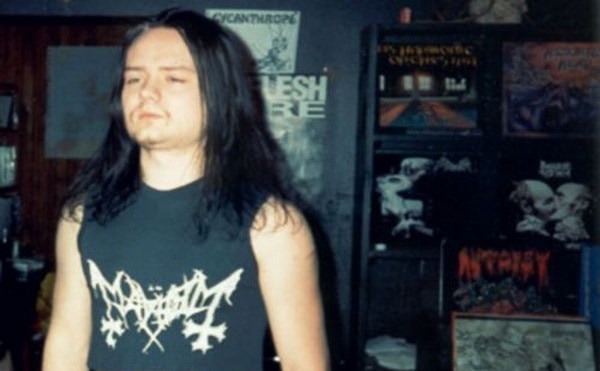
While it is questioned if “Inner Circle” was ever really used as a name by those involved during the 1991-1993 events, there was indeed a circle of young people trying to impress each other with music but also for the wrong reasons. Arson, violence, hate and blood…
Many of them were just kids that loved music. Extreme music. Music that was new and primitive in the beginning but isn’t any kind of art primitive in the very beginning? Not all kinds of art are easily accessible and understandable.
Norway seemed like an isolated place. Definitely it was cold. Probably more religious than other Scandinavian countries like Sweden. Those kids wanted to live. Those kids loved extreme music and music was their life. From the moment they woke up to the moment they went back to sleep, everything was around music.
New music they were looking for, writing letters worldwide in search for alike minds, trading tapes, composing and performing their music. Extreme music. We all know how kids are (actually everyone). What is “banned” and “forbidden” is always something people are looking for. Those kids were looking for the early, banned films of directors like Sam Raimi and Peter Jackson.
The funny thing is that years later, both Sam Raimi and Peter Jackson became mainstream, from “The Evil Dead” to “Spider-Man”, and from “Braindead” to “The Lord of the Rings”.
And so did black metal and a few of those bands. From the years that media and people were talking about “everything-but-music” giving them hard time, to the moment they’re in magazine covers, festivals and gained respect for their legacy, while in the making of what’s considered “legacy”, many were against them.
“We now have the strongest line-up in the history of Mayhem”, Mayhem’s bassist Necrobutcher (born Jørn Stubberud) said to Bård “Faust” Eithun during an interview at Street Fighter in 1990. “I don’t expect any major changes, unless some of us die or get arrested”, Jørn added in 1990…
Part IV: Into the Void – The Second Wave of Black Metal (the early ’90s)
“Excuse the blood…” is the first sentence in Dead’s suicide note. Dead (born Per Yngve Ohlin, nicknamed Pelle), the Swedish singer of Mayhem from 1988, sliver his wrists and throat and shot himself in the forehead with a shotgun, on April 8th of 1991, in a house in the woods he was living with Euronymous and Hellhammer.
“I am not a human, this is just a dream and soon I will wake”, Dead also wrote in that suicide note. That act of blood and Mayhem’s live shows in 1990 are the beginning of the second wave of Black Metal.
Dead’s presence in Mayhem, his suicidal ideas , the obsession with death and self-mutilation along with the depression he was falling into (leading to his suicide), also served as the foundation of depressive and suicidal black metal along with the early works of Burzum.
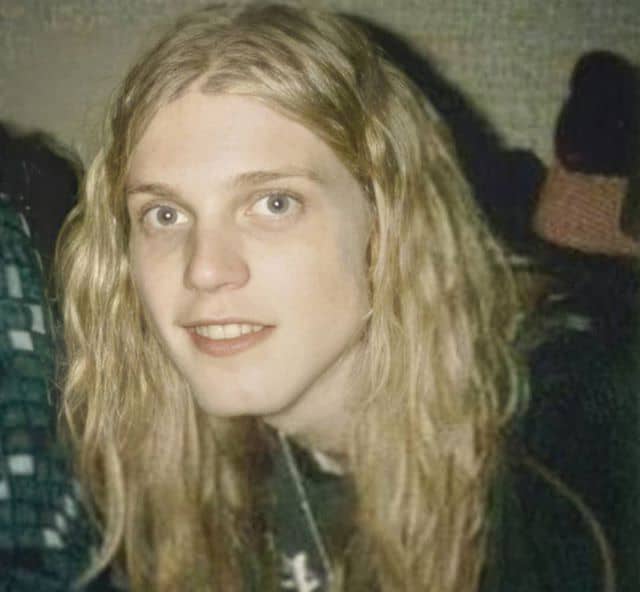
Dead’s body was found by Euronymous but the first thing he did before calling for authorities was to arrange the scene so he could take a few photographs. Euronymous used bits of Dead’s skull, which were given to selected people of the scene that were close to him and “comrades of Dead” as Marduk’s Evil (Morgan Håkansson, one of the 5 to 10 people that got one), has said to Loudwire in 2012.
As for that famous photos that were supposed to be destroyed, one of them ended on the cover of the (most) notorious bootleg live album “Dawn of the Black Hearts” that was first released in 1995 by the Colombian Warmaster Records with the catalogue number prefix “ANTI GRISHNACKH” including the Mayhem live show of February 28th of 1990 in Sarpsborg, Norway.
Not many people seem to know that this specific gig was part of the “Support for Slayer Magazine” festival, organized by Metalion (Jon Kristiansen, a key figure of the scene) of Slayer Magazine. Adding detail to the story, the owner of Warmaster Records was Bull Metal (born Mauricio Montoya Botero) who was a member of Colombian bands like Agressor, Masacre, Typhon.
He was a friend of Euronymoys and got the photo directly from him since he introduced Euronymous to the Colombian extreme metal scene who already had an important act like Parabellum in the ’80s, an influential band for early Mayhem. As for the audio of that gig, Bull Metal got a VHS from Metalion including the Sarpsborg show. Just like Pelle, Botero was found dead in December of 2002, commiting suicide.
Dead’s suicide caused a crack among Euronymous and a few of the people in the scene, starting with Mayhem’s bassist Necrobutcher who left the band afterwords when he found out that Øystein took pictures of the dead body and years later said that he wanted to murder Euronymous because of his attitude.
Pelle was also a friend of Necrobutcher and Jørn was mad because Euronymous didn’t even let him grief the loss of their singer and friend, and just found a way of exposure his suicide. Pelle’s death served Euronymous’ purpose to spread his ideas and the name of Mayhem, leading to the opening of Helvete and the beginning of the Norwegian Black Metal scene.
The bands that were formed after leaving the death metal territory following Euronymous’ war against it, became the iron hand of black metal. Having already joined Peaceville Records and leaving death metal behind, in 1992, Darkthrone released “A Blaze in the Northern Sky” setting new standards in the black metal sound.
However, it was already Snorre W. Ruch (using also the stage name Blackthorn later) and the “Grymyrk” tape of his band Thorns that created the Norwegian guitar sound we all know. “Grymyrk” was actually 6 tracks of guitar and bass only, recorded in 1991 by Snorre and bassist Harald Eilertsen, so the other two members of ex-Stigma Diabolicum, singer Marius Vold and drummer Bård Eithun (Faust) could listen.
Euronymous was heavily inspired by that recording and more or less, Blackthorn and Euronymous sat down and created what is known as the tremolo-picking Norwegian black metal riffing style. Later in 1992 Euronymous and Snorre agreed to play second guitar in each other’s band.
Thorns went on hold and Blackthorn briefly joined Mayhem but didn’t record any guitar, even if he had an input in guitar arrangements. “Euronymous felt that Snorre was the future of Mayhem”, Attila Csihar said to Finn Håkon Rødland during an interview for the 25th anniversary vinyl box set edition of “De Mysteriis Dom. Sathanas”.
No one can really write the complete story of a genre that is more than music until the mid-90s. And since it is “more than music”, there are really no rules and guidelines. Someone could say that the story of Mayhem is the story of Black Metal.
Also, according to “album release dates” some people might say that Darkthrone’s “A Blaze in the Northern Sky” (1992) is the first true Norwegian black metal album while in the pre-banned Burzum-era, Count’s debut album was also close enough, even if it’s not mentioned in articles as such, over the last years (“banned”).
However, probably none of those would exist without the (true) Mayhem line-up of Dead, Euronymous, Necrobutcher and Hellhammer that shaped the (true) Norwegian black metal with their live shows during 1990, starting with the live show in Jessheim, in February the 3rd of 1990.
A few months later, Mayhem tried to “tour” in Europe but they ended in Turkey for a “half” show, missed a show in Greece due to misunderstandings (everything was arranged mostly with letters back then) and performed twice in East Germany, one year after the fall of the Berlin Wall, at the period of reunification.
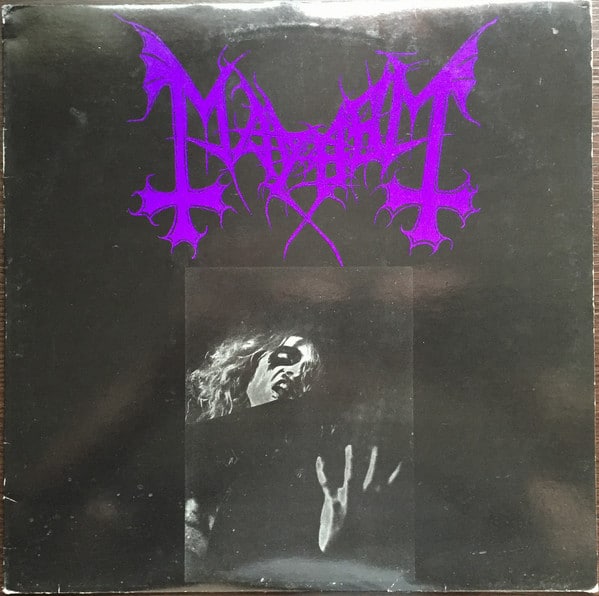
Released by Obscure Plasma in 1993, Mayhem’s “Live in Leipzig” (recorded in November 26th of 1990) presents one of those shows where people could hear songs like “Funeral Fog”, “Freezing Moon”, “Buried by Time and Dust” and “Pagan Fears”, would see Euronymous guitar playing and riffing, Hellhammer’s pounding and death’s shadow surrounding Dead slicing himself.
You can ignore official release dates and albums, and just bring yourself among all those people that witnessed a Mayhem live show in 1990. Among those people that were also (or became) members of so many black metal bands you can’t even imagine. Then, you can understand the beginning of Norwegian Black Metal and how it led to the greatest Black Metal album ever recorded.
However, just like every genre and every innovator, there will always be rare and obscure moments in the past that “it has been sort-of played before” just like the German punk rockers EA80 and their “2 Takte Später” album of 1985 including tracks like “Nimmer Geh Beiseit” where you can hear a similar technique already.
A few music nerds and “people that want to state something different” will always bring in front similar things like this, even if it doesn’t matter. In black metal though, it is mentioned many times over the years that many of its musicians were into punk, punk-goth, avant-garde and bands like Dead Can Dance, even techno and electronic music.
And in the years to come, all those influences came upfront in the evolution (or deformation for some) of Black Metal, which became the most diverse metal genre.
Back in 1992, when Bathory had already left behind black metal and besides Darkthrone’s “A Blaze in the Northern Sky” and Burzum’s same-titled debut album, Immortal released “Diabolical Fullmoon Mysticism”, Samael from Switzerland released “Blood Ritual” (the follow-up to “Worship Him”), Master’s Hammer from Czechoslovakia released “Jilemnický Okultista” (the follow-up to “Ritual.”) and Acheron from the United States released “Rites of the Black Mass”.
Back then, black metal had a strong do-it-yourself and lo-fi profile as opposed to mainstream music. Black Metal started spreading all over the world but the most important scene besides Norway, was Greece.
Greek Black Metal Scene
During 1993 to 1996 alone, in Greece were released iconic albums of Rotting Christ (“Thy Mighty Contract”, “Non Serviam“, “Triarch of the Lost Lovers”), Varathron (“His Majesty at the Swamp”, “Walpurgisnacht”), Necromantia (“Crossing the Fiery Path“, “Scarlet Evil Witching Black”), Thou Art Lord (“Eosforos”, “Apollyon”), Zemial (“For the Glory of UR”) and Agatus (“Dawn of Martyrdom”).
The Hellenic black metal scene also included bands like Deviser, Kawir, Nergal, Order of the Ebon Hand, Nocternity, Astarte, Ravencult, while there were also cases of far-right bands associated with Golden Dawn, like Naer Mataron and Legion of Doom who included the swastika symbol in their debut album “Kingdom of Endless Darkness” (1995) and shortly after that, they joined the short-lived Hypervorea Records of Magus Wampyr Daoloth (previously known as Morbid, later as The Magus, born George Zacharopoulos), founder of Necromantia and co-founder of Black Lotus Records.
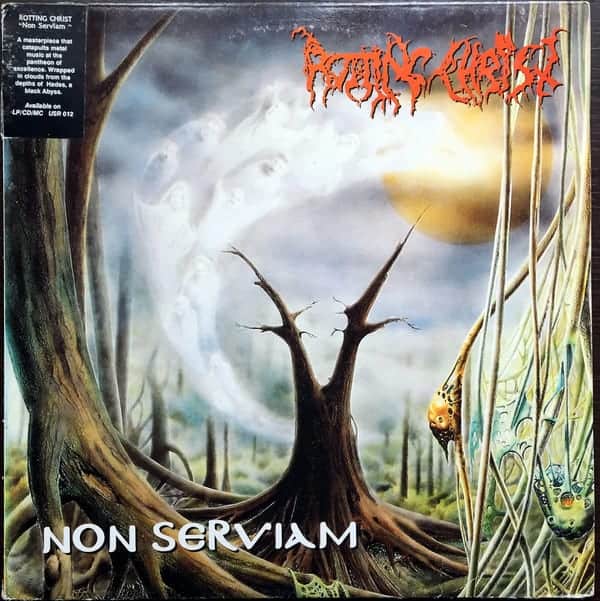
The Hellenic black metal has a very distinguished sound as shaped by the early albums of Rotting Christ (mainly) and Varathron, while Necromantia presented a unique approach with 8-string bass guitars, occasionally using guitar only for the solo parts.
Bands like Rotting Christ and Necromantia also had a very strong and atmospheric use of keyboards in the early years, something that should be credited to Magus Vampyr Daoloth who was also active in more diverse projects like Diabolos Rising, an industrial vampiric act with Mikka Luttinen of Impaled Nazarene (who later became Raism) and N.A.O.S. with its atmospheric gothic music.
In recent years he is active with Principality of Hell and he was joined with ex-Rotting Christ bassist Mutilator (born Dimitrios Patsouris) in Yoth Iria. Still though, the songwriting and riffs of Necromayhem (born Athanasios Tolis) in the early Rotting Christ years is what made the Hellenic black metal what it is, while Rotting Christ is now considered as one of the greatest black metal bands.
Osmose Productions from France that was founded in 1991, started signing bands that became very important for the genre, releasing all over the ’90s a few of the best albums of the genre. Necromantia, Rotting Christ, Immortal, Marduk, Enslaved, Impaled Nazarene and Samael were among them.
Besides the fact that many record labels started getting an interest in black metal, labels specialized to the genre (and dark music in general) started forming, like Misanthropy Records in the UK, Avantgarde Music in Italy, Last Episode in Germany, Unisound in Greece, No Fashion Records in Sweden, while in Norway there was Moonfog Productions founded by Satyr of Satyricon and Head Not Found owned by Metalion.
Notable mention to the already existing Cold Meat Industry in Sweden that served as the home of names like Mortiis, Aghast, Brighter Death Now, ambient, dark wave and industrial, music directions that were very related to many black metal artists that formed similar projects.
Among those labels, there was another one formed in Austria and released albums of Abigor, Summoning and Nåstrond among others but now it has become a major player in the music industry and mainstream metal: Napalm Records.
Part V: The Events
Metal music was moving to extreme and dark paths. Extreme music needs extreme lyrics and imagery to reach the edge. Many private releases, demo tapes, albums and alliances were taking shape during the late ’80s, worldwide. From Norway to mid-Europe and South America. Later during the early ’90s, conflicts and “wars” were also in the game, even among “friends”.
On August 10th of 1993, Øystein Aarseth (Euronymous) guitarist and leader of Mayhem, was murdered by Varg Vikernes (Count Grishnackh), also a recording member of Mayhem and the man behind Burzum.
Nearly a year later, in May 1994, Mayhem’s album “De Mysteriis Dom. Sathanas” was finally released. In the same month that Vikernes was sentenced in prison.
In 1993, I was 16 years old and I was operating “Metal Oath Tapes”, where I was distributing demo tapes and releasing compilation tapes including demo bands.
I was mainly focused in classic metal but a few extreme bands were also included in those tapes, plus many more for tape trading. During tape trading, I was introduced to few of those underground extreme bands and I had the luck to include even few more known bands in the compilation tapes, like Rotting Christ (thanks to Jim Mutilator).
I was 16 years old then. At the same age when Euronymous formed Mayhem. This is a weird age and for an overactive young person, you think you can change the world. I didn’t change anything, but Euronymous was among the few persons that changed the face of extreme music. With his music and his acts.
Almost one month before the murder of Euronymous (8/7/1993 is the date on the letter I have), I had an interview with Panos from Decapitated Records, that changed to Unisound Records, one of our regular suppliers of official (and unofficial) black metal.
Black metal was already growing and was an underground beast that was about to burst into mainstream. You could easily find those black albums and you could discover even more despite the fact that it was “underground”.
Many of us were fascinated with black metal and extreme music and while exchanging letters with pen pals worldwide, buying and trading tapes and fanzines, we were discovering an extreme world and extreme ideas. At least in letters.
I admit that nowadays, in the era of social media and facebook, I don’t know where many of those pen pals are, even if I didn’t meet most of them in real life. But few of them were in deep shit and ideas back then.
At least in letters. Luckily, I didn’t follow the extreme ones and I even got a letter with blood one day… I never sent something like this though, but I am sure that I also might have written silly things even if I don’t remember any.
Thing is, when you are young, you’re doing extreme things. And you think even more extreme. But while you are growing and shaping your personality, you change your mind, you regret and you push your mind to forget them. People that might share extreme acts will probably remember them, but also push themselves and mind to forget them. And subconsciously you will forget them and won’t admit them. But there will always be few people that remember those acts.
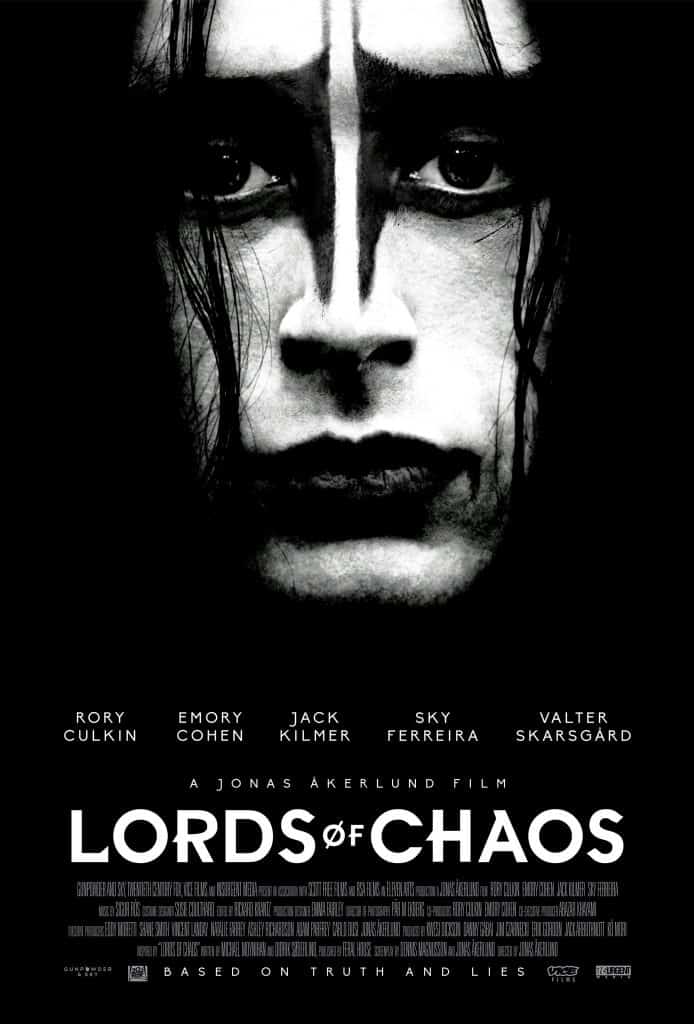
Jonas Åkerlund’s film “Lords of Chaos” (2018) is an adaptation of the 1998 book based in the events surrounding the Norwegian black metal scene, Mayhem and the murder of Euronymous.
The film is based in truth and lies. But someone’s truth is someone else’s lie, and someone’s lie is someone else’s truth. Plus, there are always in-between the acts of those young persons that pushed themselves and minds to forget them. They don’t remember them or they don’t want to remember them. And that’s the point where confusion, truth and lies begin.
How did the EVENTS start? Per Ohlin’s suicide was the death of “innocence” and along with the opening of Helvete and the informal creation of Inner Circle, the second wave of Black Metal was typically started. Until that point only “words” were extreme but after Dead’s suicide, the words became acts and even more.
Arson and destruction, death threats, blood and finally, murder. They were just kids at the time. “A few friends of ours were killed and killed themselves”, Necrobutcher said to Iron Fist magazine in 2014 and that kind of memory is not something you can easily forget.
Members of the Norwegian black metal scene started the Church burnings and those arson attacks were an attack against Christianity. Among those burnings, important historical buildings were burnt including the Fantoft Stave Church whose burnt image appears on the cover of Burzum’s “Aske” EP, released in 1993 with some copies packaged with a zippo lighter bearing the album’s cover image.
“Aske” (meaning “ashes”) was released in the March of 1993 by Euronymous’ Deathlike Silence label and a rivalry had already arose between Euronymous and Vikernes for a variation of reasons depending the view: each one claiming a leading role in the scene or a financial dispute over Burzum records. The black metal scene was already on the spotlight in Norway’s media.
“WORDS”. Sometimes words are fake or used to impress but those “words” can be translated as “acts” by those who are reading or listening to them. The first half of 1993 was the period that changed everything and black metal was brought heavily in the media.
Varg Vikernes gave an anonymous interview to a journalist talking about his beliefs, the Church burnings, even about a traceless murder of a gay man in the summer of 1992, connecting all of them with black metal and an intention to spread fear and evil. {Or at least this is what mostly is believed, but according to Varg, everything was “fake” just to raise interest to black metal and help Euronymous’ store}.

Many people of the Norwegian black metal scene drew the attention of the police and Euronymous shut Helvete out of fear and since his parents told him so. That interview didn’t appear as “anonymous” and media used his real name (Kristian Vikernes) so terrified as he was because of the “Kristian” name that is connected to Christianity and Christ opposed to his beliefs, he legally changed it to “Varg” and since the anonymity was ruined, he stopped using a pseudonym.
Mayhem’s “De Mysteriis Dom. Sathanas” was in the final stages, recorded by Euronymous (guitar), Hellhammer (drums), Attila Csihar (vocals) and Varg Vikernes (bass).
Dead already had lyrics and lyric notes, Snorre Ruch arranged and completed many of them for Attila but at that point Varg didn’t want to have any relationship with Euronymous since he owed him money for the Burzum records (even if Varg didn’t seem to have financial problems) and Varg believed Euronymous was “fake” and openly blamed him. At that point, Euronymous believed that he was no longer the “leading character” in the scene and rumours started to spread in the scene. Among “friends”.
Snorre Ruch also briefly joined Mayhem taking part in rehearsals (“guitar arrangements”) and inspiring Euronymous who even asked for a few riffs (like the ones from Thorns’ “Lovely Children”) and he was a friend to both Euronymous and Varg.
It is said that Euronymous had plans to kill Varg and among the people that he told so, was Snorre, and Varg knew it.
On the night of August 10th of 1993, Varg Vikernes and Snorre Ruch drove from Bergen to Euronymous’ apartment in Oslo. Snorre stood outside in the car. Varg confronted Euronymous, they got into a struggle and Vikernes stabbed Euronymous to death. On August 19th, Vikernes was arrested.
All over the following months, many members of the black metal scene were taken by the authorities for questioning. Faust was also arrested and confessed the traceless murder in the summer of 1992. Snorre’s confession was a mess of fear and panic.
Vikernes was sentenced to 21 years in prison (Norway’s maximum penalty) for the murder of Euronymous, the arson of four churches and for possessing 150 kg of explosives. Snorre Ruch was also sentenced to 8 years in prison for being an accomplice.
Euronymous’ murder was considered as an act of treason by many members of the scene and a fight of “words” followed (even among “friends”), where iconic members of the Norwegian black metal scene were accusing each other, and in the later years adding their own perspective, or repenting. Just after Varg’s conviction, many people in the scene were openly against him with a notable exception of Fenriz and Hellhammer.
There is a debate about art that is getting stronger and more confusing over the last years. Should we separate the artist (the human being) from his art? Many times we all fall in this trap and sometimes we pretend about it, but there are cases that the art is an extension of the artist and cannot be separated. Either you accept it, or not.
As Mark Shelton sang in Manilla Road’s “Crystal Logic”, “there’s good and there’s evil, there’s no in between”. Still though, sometimes we made a “personal peace” with a few artists and bands because of their “art”, even if we despise their personal views and ethics. Right or wrong, we all have done it.
Besides the music legacy and influence, a few of those young people were insecure kids that wanted to make a bold statement; a false revolution. Kids were in their early 20s, others even younger… Individuals that hadn’t even shaped their personality.
They wanted to be extreme and presented extreme ideas. Few of them moved to extreme acts and crimes. Acts and beliefs like those need to be isolated but back in the early ’90s, many minds were poisoned with extreme ideas and beliefs. Satanism, nationalist beliefs, self-mutilation, blood and violence, oppression and corruption. Even if it was fake or part of an act for a few of them.
When Darkthrone released “Transilvanian Hunger” in 1994, there was the phrase “Norsk Arisk Black Metal” (Norwegian Aryan Black Metal) in the first pressing. There was a negative response since the album was released by the UK-based Peaceville Records and had a major distribution network unlike other underground releases and labels.

“We would like to state that Transilvanian Hunger stands beyond any criticism. If any man should attempt to criticize this LP, he should be thoroughly patronized for his obviously Jewish behavior”, was Darkthrone’s response for an album including lyrics also written by Varg Vikernes. In later pressings, the phrase was replaced with “True Norwegian Black Metal” and the band issued an apology-excuse that didn’t really convince the people. Fenriz regretted those statements “of the past” and made peace with his younger, “rebellious” self of his early 20s.
Few of those bands and people were trying to appear extreme and most of them regret it. Few of them didn’t, but in any case, as Friedrich Nietzsche wrote, “He who fights with monsters should look to it that he himself does not become a monster. And if you gaze long into an abyss, the abyss also gazes into you” – Beyond Good and Evil, Aphorism 146.
Part VI: Five people that shaped Black Metal

The Black Mark of (Black) Metal: Quorthon
(Born Thomas Börje Forsberg) Quorthon is the son of Boss (born Stig Börje Forsberg) head of Tyfon Grammofon and Black Mark Production. The young Swedish “Ace” became “Quorthon” and formed Bathory in 1983, the band name used for the two tracks that were included in the “Scandinavian Metal Attack” compilation (“Sacrifice”, “The Return of Darkness and Evil”). Shortly, the band became a “one-man” act and every few years, Quorthon was inventing metal subgenres, starting from Black Metal, and later Viking Metal.
The first three Bathory albums, “Bathory” (1984), “The Return……” (1985) and “Under the Sign of the Black Mark” (1987) are the cornerstone of Black Metal. With “Blood Fire Death” (1988) he introduced more elements to the variety of the genre and later he created Viking Metal with “Hammerheart” (1990) while he also released albums that are the true essence of Epic Metal. Still though, in “Twilight of the Gods” (1991) his lyrical themes stray from “typical” epic metal, using allegories for the modern age.
Truth to be told, you can’t really pin Bathory down to one style and sound; Bathory is a lot of things. “People have always had bigger problems with Bathory’s image and the image of Quorthon than I have”, Quorthon said to Luxi Lahtinen during an interview for the album “Destroyer of Worlds” (2001) but before the internet-dominated world, any rumor could be true, and Quorthon was a personality of many rumors and myths.
People and fans always had a different and personal perspective to what Bathory is for them. From the early promo photos (inspired by Venom, no matter what Quorthon said) to a few interviews where Ace was sharing amazingly funny tales, almost hard to believe, and giving unbelievable answers too, he was everything you believe and everything you don’t believe. Quorthon died from heart failure at the age of 38 in 2004 and we can’t even imagine what else he would offer to music.

The Heart of Black Metal: Euronymous
(Born Øystein Aarseth) Euronymous formed Mayhem with Necrobutcher (born Jørn Stubberud) in 1984. From the early years and the release of “Deathcrush” EP in 1987, Euronymous believed that the bands should keep extreme music against trends and any form of commercialism.
Despite the far-right views many black metal bands had in those years and the years that followed, Euronymous claimed he believed in “communist dictatorship” and he was even a member of the Red Youth in Norway according to some sources.
After Dead’s suicide and the opening of the Helvete store, he was considering himself as the archetype black metal figure and the leader of the Norwegian black metal scene. He was always focused on Mayhem’s music even if many times he was distracted by other factors like his record label, but also all those ideas and rumors he was trying to spread, always keeping his presence in the middle.
Euronymous was opposed to LaVeyan Satanism (which King Diamond believed in) and individuality, and believed in the personified Satan and theistic Satanism, claiming that people should obey their religion.
Still though, for some people he was an “act” while for others he was a true Satanist but various members of many bands (including Emperor, Arcturus, Enslaved) believed in his advice and suggestions, considering him very helpful.
“I believed everything he said”, Sverd (born Steinar Sverd Johnsen) of Arcturus and Mortem has said to Finn Håkon Rødland during the interview for the 25th anniversary edition of “De Mysteriis Dom. Sathanas”, the greatest Black Metal album ever recorded; the nearly mythical album that is the heart of Euronymous, who was murdered by Varg Vikernes at the age of 25 in 1993.
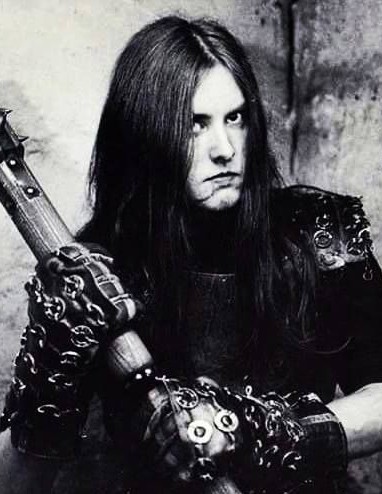
The Blood of Black Metal: Varg Vikernes
Count Grishnackh, born Kristian Vikernes, lately officially in “papers” Louis Cachet. The man of many names (and many characters according to the media), the founder of Burzum, one of the most influential and controversial acts of black metal.
Burzum represents everything that can go wrong and everything that is wrong, but at the same time, everything that is original and untameable according to the individual and his acts, since Varg has no regrets.
From primitive black metal to dark ambient, Burzum’s discography is the soul of Vikernes and despite a common belief it is not much related with his personal views and beliefs. Also, Vikernes was never really influenced by Satanism even if he called himself as such in early years to provoke hostility against Chrstianity.
Burzum’s music was personal, based in darkness, Scandinavian fairy tales and fantasy magic out-of-this world. But it is not only his music that was influential in black metal, since his political views and ideas (the heart and mind of Varg) poisoned the world of black metal.
From the ashes and Euronymous’ blood, and while being imprisoned, Varg launched neo-Nazi views of hate dressed in a “pre-industrial European pagan society”, a “Europe is not a geographical, but a biological term” and an “odalism” banner through published books and a blog.
He was finally released from prison in May 2009 but since then, he has been associated on suspicion of planning acts of terrorism and hate speech that led to multiple removals of his personal YouTube channel from the platform.
Furthermore, words like “Burzum” and his music are often banned and removed in various social media and platforms, while in Norway, Varg Vikernes was a persona non grata. Soon enough, everything related to Burzum worldwide started to be banned and forbidden, no matter of how important the music was for the genre.
Albums, the music, even the history itself, like Burzum never really existed within the realm of black metal, just the person and his acts.
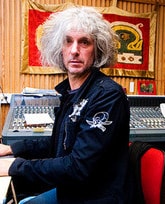
The Sound of Black Metal: Pytten
(Born Eirik Hundvin) Pytten is a producer, recording and audio engineer responsible for the sound of more black metal albums you can imagine. Among them, the early albums of Burzum, Emperor, Immortal, Enslaved, Gorgoroth and of course, Mayhem’s “De Mysteriis Dom. Sathanas”.
Grieghallen (Grieg Hall), a concert hall located in Bergen, Norway and named after the composer Edvart Grieg, is a famous facility featuring every kind of concerts, from symphonic music and jazz to rock and pop, including also a Eurovision song contest.
That facility also had recording rooms and a studio. Who could imagine that in Grieg Hall were recorded all those iconic Norwegian black metal albums? Pytten’s “Grieghallen sound” is the analogue sound of Black Metal.
He understood the “chaos” of those young musicians and what they had in mind. Others recorded in a very dry recording room in order to catch a “cold” guitar sound without any echo, while Hellhammer’s drums for “De Mysteriis Dom. Sathanas” were recorded on the main stage of the concert hall in order to catch that huge sound.
“Everything was planned to every detail”, Pytten has said about the recordings of “De Mysteriis Dom. Sathanas“, he saw dedicated people working on this release and everyone knew this was going to be something very important.
He was shocked with the vocals of Attila Csihar, he knew Euronymous’ high position in the scene and he liked the fact that a black metal guitarist used a traditional rock equipment like a Les Paul guitar and his own amplifier. As for the master tapes of many of those recordings, they are now part of the national library.
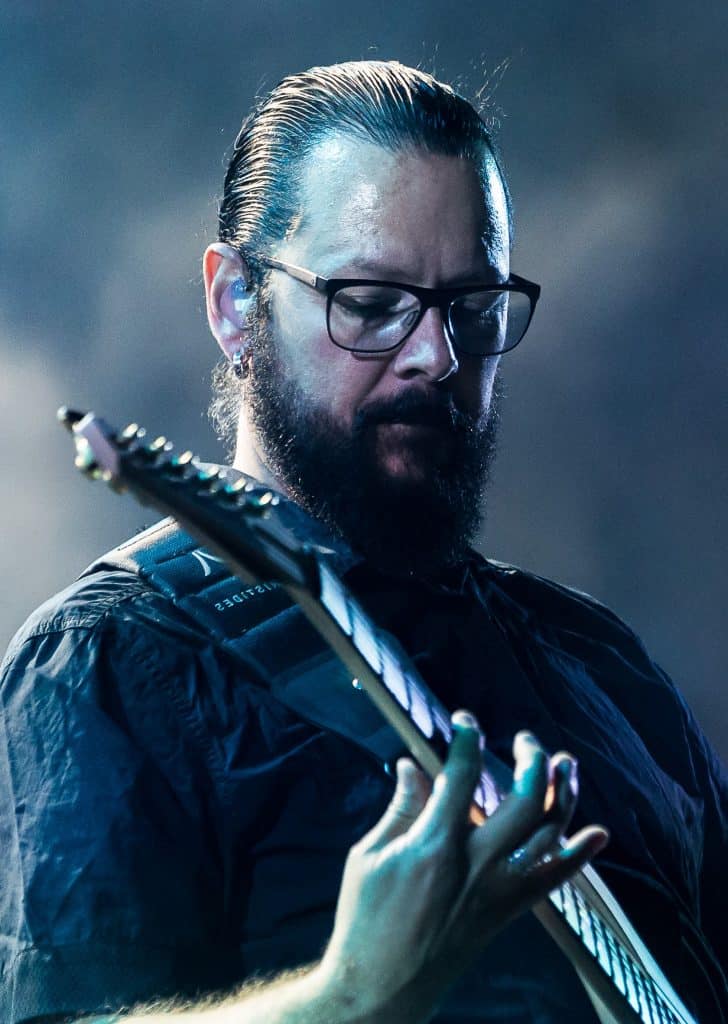
The Mind of Black Metal: Ihsahn
(Born Vegard Sverre Tveitan) the young boy from Notodden learned playing guitar from Iron Maiden tab books and his favourite album “Seventh Son of a Seventh Son”, after seeing the British metal gods as a kid during that tour. “From the moment Bruce Dickinson jumped onstage with the pyro during Moonchild, I can’t recall having had a plan B”, Ihashn said to Kerrang!
“It had a huge impact on me. I got the tablature book for that album, and that was my musical education. I would spend hours after school playing along and emulating what they were doing.”
He studied Iron Maiden, the melodies, the solos and phrasing, and started playing music with his first professional recordings at the age of 14. He formed Emperor at the age of 16 in 1991 using the stage name Ygg along with Samoth who was one year older and Mortiis who was at the same age. In 1992, they recorded the “Wrath of the Tyrant” demo.
Mortiis was writing the lyrics and the other two were writing the music, while Samoth also performed drums before switching to guitar when Faust joined next year.
Ygg became Ihsahn and Emperor one of the greatest black metal bands. While he also jumped on the satanic wagon and was encouraged by Euronymous, Ihsahn didn’t participate in extreme acts and after the release of Emperor’s debut album “In the Nightside Eclipse”, he was the only Emperor member that didn’t end behind bars.
Besides Iron Maiden, Ihsahn was also influenced by Mercyful Fate/King Diamond and Pink Floyd, and he was always serious with his art. However, after the release of “IX Equilibrium” (1999) he felt threatened by his own creation.
When he felt that Emperor was no longer “his band” and thought that fans and other people “owned them” and had specific demands for that name, he stopped writing new music for Emperor. Emperor’s last album was “Prometheus – The Discipline of Fire & Demise”, released in 2001 while Ihsahn was just 26. The band was becoming commercially successful but Ihsahn wanted Emperor to “evolve” while others didn’t.
Since then, Emperor keeps performing occasionally live shows but Ihsahn’s new music is released and performed mainly under his name. Somehow, Ihsahn took his revenge since a few of the Emperor albums didn’t get the proper recognition during their release but when he stopped writing new music and after a few years, the Emperor name has reached an iconic status and he always gets compliments for his achievements and musicianship.
Still though, he always respected the specific feeling and the impact the Emperor albums have upon people and he never tried to emulate it, if he doesn’t believe he can really do it from his heart.
Part VII: The Vortex Void of Black Metal (from ’90s and beyond – the different faces of darkness)
More bands started to appear all over the world including Profanatica, Havohej, Judas Iscariot and Grand Belial’s Key from the United States, Ancient Rites from Belgium, and also bands that in the next years became mainstream acts, like Behemoth from Poland, Cradle of Filth from the UK and Dimmu Borgir from Norway.
Cacophonus Records in the UK was one of those labels that gave the first step to bands that dominated the next years. Starting with Cradle of Filth’s “The Principle of Evil Made Flesh” in 1994, it was the same label that released early albums of Bal-Sagoth, Gehenna and Dimmu Borgir.
With Mayhem’s “De Mysteriis Dom. Sathanas” finally released in 1994, Euronymous dead, Vikernes in jail and a huge exposure in media, it took no long for established labels to approach extreme metal bands of that kind, starting with Nuclear Blast that signed Dissection from Sweden, for the release of their second album “Storm of the Light’s Bane” in 1995, opening the gates for other labels to welcome black metal.
And while we’re still in the mid ’90s, the second wave of black metal started already to become something different so at that point, we’re somehow in the same era of that second wave but also at the beginning of the third wave and other variations of black metal.
Shortly after the release of their debut full-length album, Cradle of Filth joined Music For Nations label leaving behind the era of touring with Emperor in the UK in clubs with a handful of people attending. Shocking the world was also in the game, with merchandise like the infamous t-shirt of a masturbating nun and the “Jesus is a cunt” slogan or the “From the Cradle to Enslave” video clip.
Albums like “Dusk and Her Embrace” (1996), “Cruelty and the Beast” (1998) and “Midian” (2000), established Cradle of Filth as a huge touring act and part of major festivals in Europe and the USA, while they were changing their style from black metal adding symphonic and gothic elements, even classic metal parts, reaching a wider audience and eventually becoming a mainstream act.
At the same time, Dimmu Borgir joined Nuclear Blast and starting with albums like “Enthrone Darkness Triumphant” in 1997 up to “In Sorte Diaboli” a decade later, they managed to sell hundreds of thousands albums, even entering the Billboard charts.
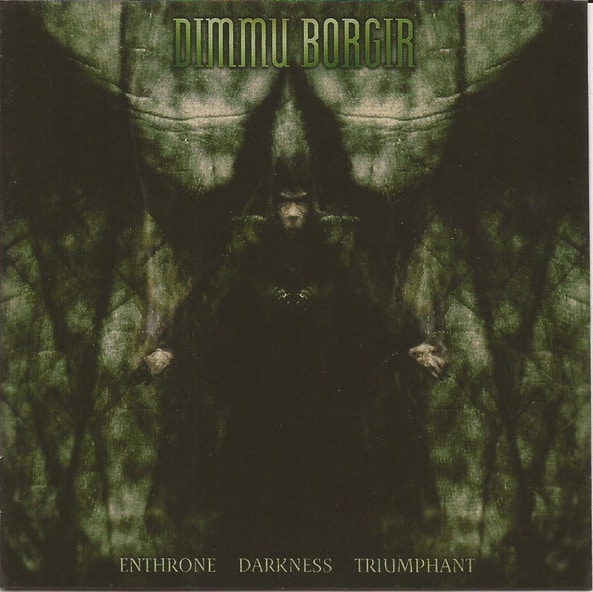
Snowy Shaw, former drummer of King Diamond and Mercyful Fate, joined Dimmu Borgir for a while in 2010 and wrote in his biography that this band was actually a huge organization where everything was handled by the management and only Shagrath (born Stian Tomt Thoresen) and Silenoz (born Sven Atle Kopperud) were the actual leading members.
During those years, many respected musicians of the extreme metal community became part of this commercial organization, including ICS Vortex (born Simen Hestnæs) of Arcturus and Borknagar, Galder (born Thomas Rune Andersen Orre) of Old Man’s Child, Nicholas Barker of Cradle of Filth among others, even Hellhammer of Mayhem.
Meanwhile, even iconic bands of the second wave of black metal like Immortal joined labels like Nuclear Blast in 2002 releasing a solid album under the name “Sons of Northern Darkness” while in the same year Satyricon released “Volcano” through Capitol Records of Universal Music Group.
Black Metal was no longer an underground form of music for a few people, it was a subgenre with commercial success. Bands were already in major record companies, they were in magazine covers and secured high spots in huge festivals like Download, Ozzfest and Wacken Open Air.
At that point, black metal was already different, a subgenre of many faces. Bands like Gorgoroth and Marduk kept the ’90s black metal satanic and anti-christian style with their members following that path in their real life. In this “orthodox” black metal style from 2000 and on, there were full-album releases by bands like Funeral Mist, Antaeus, Deathspell Omega and Watain who crushed the barrier between the underground and the mainstream.
“Breaking that barrier means a lot to some people, both in a negative and positive way”, Erik Danielsson said to the first issue of Iron Fist magazine. “My definition of the underground died a long time ago”, Watain’s voice added and black metal stopped being a strictly underground entity since Euronymous’ death.
The extreme ideas and hate propaganda is still there though, lurking in the underground scene, in specific record labels, bands and circles, finding the way to a few festivals and media, even if people are more cautious in recent years.
Among them bands like Clandestine Blaze, Spear of Longinus, Peste Noire and many more who have no problem to bring upfront their beliefs, or other bands like Taake who disguise their repulsive neo-Nazi views behind a provocative concept of “extreme music needs extreme ideas”.
The “only music matters” motto is something that has many different views, no matter what’s the “personal peace” each individual has made with a few musicians separating their art from their acts, beliefs and words. On the other hand (and against any act of hate), rebellion is not just about going to the edge but also about breaking the edge and making a stand against all wrong.
Many iconic bands of the second wave of black metal kept moving, evolving-changing-transformed. Darkthrone moved away from the black-and-white album covered necro-black-metal to the ultimate glorification of the ’80s spirit with excellent albums like “The Underground Resistance” and without live shows in their life, Fenriz (born Gylve Fenris Nagell) and Nocturno Culto (born Ted Arvid Skjellum) keep releasing a new studio album very often, like they’re indeed in the ’80s.
Rotting Christ passed from the Osmose/Unisound years to Century Media, changing style and logo releasing something more mainstream but yet magnificent (“A Dead Poem”) until their new era starting with the exceptional “Theogonia” (2007), a modern classic for a younger generation of fans.
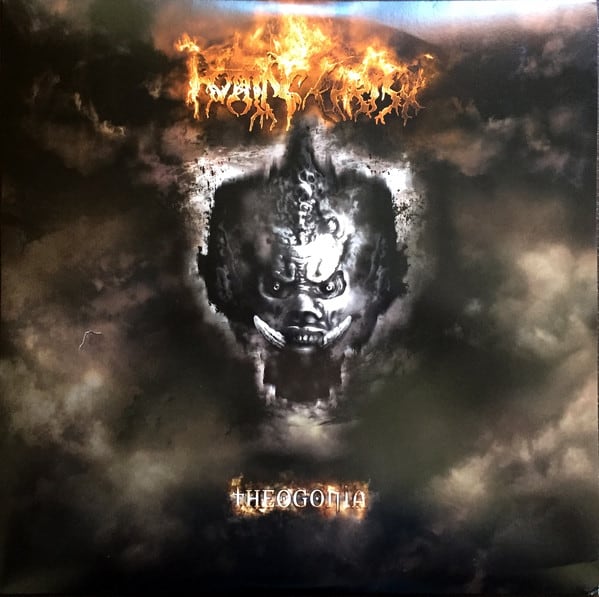
Bands like Gehennah, Bewitched, Aura Noir, Absu, Nifelheim, Desaster and Deströyer 666 performed black thrash metal while other acts were in the death black metal field like Behemoth and Belphegor, while deep underground there were many more like Mystifier, Blasphemy, Archgoat and Revenge.
And while these were more or less close enough, there is also the industrial black/death metal of Zyklon, Mysticum, even Anaal Nathrakh and of course the visionary Thorns of Snorre Ruch, a league on his own.
Bathory’s Asatru period created viking metal and influenced a wave of folk and pagan black metal bands who were focused in folklore, mythology and paganism, but also spirituality and mysticism. Among them, the remarkable Moonsorrow, Windir, Kampfar and Einherjer but also Enslaved and Borknagar who also evolved a strong progressive element in their albums.
Some people also include In the Woods… in this category because the Norwegian band was among the first ones who used the “pagan metal” term. However, in a wider epic black metal category, we can even add artists like Summoning, Macabre Omen, Caladan Brood, Emyn Muil, even Demonaz’s viking metal solo album “March of the Norse”.
There are cases like Goatlord from the United States and Necros Christos and The Ruins of Beverast from Germany adding doom metal elements. However, depressive black metal (or suicidal black metal) is not really related with (true) doom but with funeral doom in cases like Nortt.
The moody feeling of sorrow and depression is there and to those feelings, bands like Shining, Strid and Xasthur, added themes and a philosophy of misanthropy, self-harm and suicide, with music inluenced by Burzum. The weird (fake) case of Silencer from Sweden was built in self-harm and insanity.
When the “First Spell” EP of Gehenna was released in 1994 by Metalion’s Head Not Found label, Metalion promoted the release as majestic black metal. That term was also used for bands like Emperor, Limbonic Art and early Arcturus but in the years to come, it became mostly known as symphonic black metal including Covenant, Dimmu Borgir, even Bal-Sagoth.
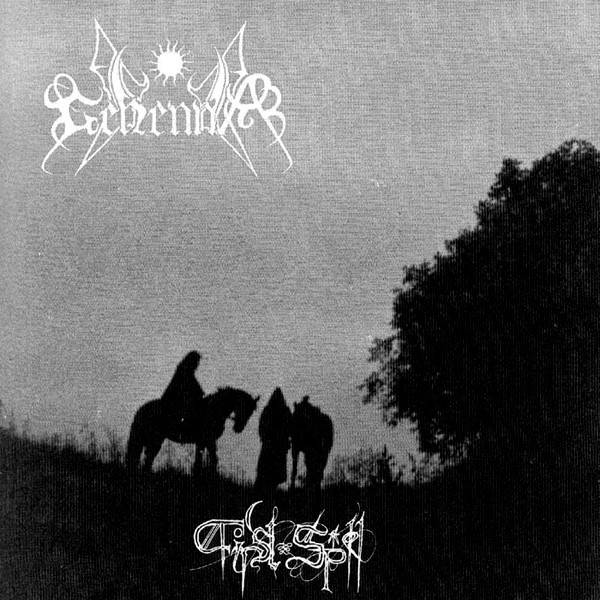
The case of ex-Emperor bassist Mortiis (born Håvard Ellefsen, a very knowledgeable person in all kinds of metal) is also remarkable with his ambient music starting with the “Født til å herske” album of 1994 and also his Vond project. However, Varg Vikernes is also a very influential person in ambient black music starting with “Hvis Lyset Tar Oss” album of 1994 and the 14-minute closing track “Tomhet”.
When Arcturus released “La Masquerade Infernale” in 1997 things had already evolved to something completely out-of-the-box but many people still considered them part of the black metal scene even if they were actually transformed to avant-garde metal with a strong progressive vibe.
As for fellow Norwegian artists Ved Buens Ende who released “Written in Waters” two years earlier, there was always a debate if that was actually “black metal”, still though, it served perfectly as an album proving that black metal actually doesn’t have clear borders and also that it is an artistic genre beyond “the devil’s culture”.
When Varg Vikenres recorded “Hvis lyset tar oss” in 1992, more or less, he created atmospheric black metal but this is known nowadays as the music of bands like Saor, Panopticon, Agalloch and Wolves in the Throne Room. The main characteristic of those bands is the atmospheric, avant-garde and ambient part, a poetic and/or folk approach with the lack of many extreme and aggressive parts of the early ’90s Norwegian black metal style.
For many people, a few of those bands have evolved to something that is not really “black metal” anymore and here you have the addition of the post-black metal term (shoegaze-black-metal?) something that fits better to acts like Myrkur.
Close to them, there are the cases of bands like Sólstafir and Alcest. At the same time, there is another wave of diverse artists with a strong psychedelic touch like Oranssi Pazuzu, or bands that balance between progressive metal, avant-garde and black metal. All of those bands are very difficult to be labelled, they have different albums and also a diverse audience; bands like Solefald and Hail Spirit Noir.
In the end, Black Metal can also be the music separated from every early idea and lyrical confines of the genre as it was shaped in the early ’90s. It can be just the music with the artists’ personal beliefs and studies that have nothing to do with every background that was known in the iconic bands.
And at that point, you have underground artists from the 2000s, 2010s and on, like Spectral Lore, Mare Cognitum, Obsequiae and Mystras with a personal aura all over their music, even if it stands within the black metal and/or atmospheric black metal borders.
Part IX: 20 Albums that shaped Black Metal
One (main) album per band placed in chronological order so the evolution (or transformation) of the genre will be revealed in a sequence of important albums. In each mention, there are 5 more releases (an addition of 100 titles, NOT always similar) so there will be a wider guideline for the genre.
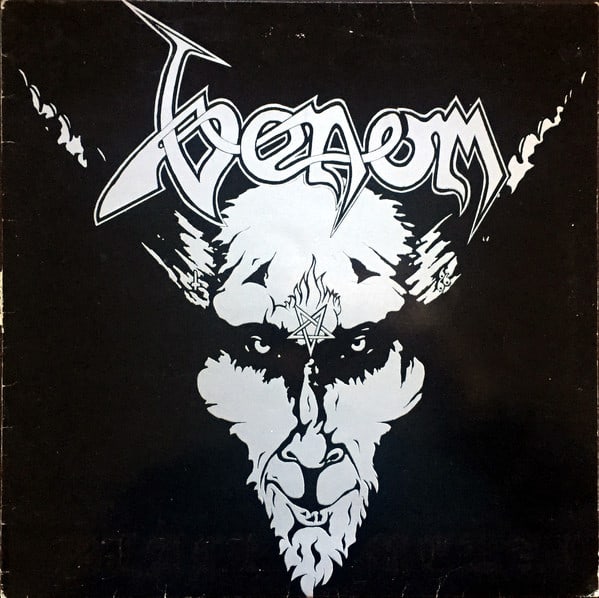
VENOM – Black Metal (Neat, 1982)
A game-changer and along with Venom’s debut album “Welcome to Hell”, the albums that made Venom one of the most important and influential bands in the history of metal music. The Godfathers of all-things-extreme and Black Metal.
In the context of its era, it was brutal, raw and shocking; Venom was the most extreme band, even if this is not your exact “black metal” as it was shaped in the early ’90s. Music, imagery, lyrics, everything was on the edge. While other bands talked about the fear of evil and Satan, Venom brought him as a pal, drinking beers with Him.
While some people use to say that they didn’t really know how to “play”, in “Black Metal” you have two (yes, 2) of the greatest metal riffs in just one (yes, 1) song; the opening riff of “Countess Bathory” and that amazing part in 01:56.
The album is full with massive riffs, from the same-titled track, a riff that inspired speed metal, thrash metal, black metal, to the opening nuclear riff of “Don’t Burn the Witch”, everything sounds inspired and influential. Then, you also have “Buried Alive”, one of the greatest Venom tracks, with the haunting opening, the malevolent and captivating evil performance of Cronos and one of Mantas’ best solos after the “let me out of here” part.
This album was history-in-the-making and the future was black and evil.
Check also (roots): VENOM – Welcome to Hell (1981), HELLHAMMER – Apocalyptic Raids (1984), CELTIC FROST – To Mega Therion (1985), SODOM – In the Sign of Evil (1985), SARCOFAGO – I.N.R.I. (1987)
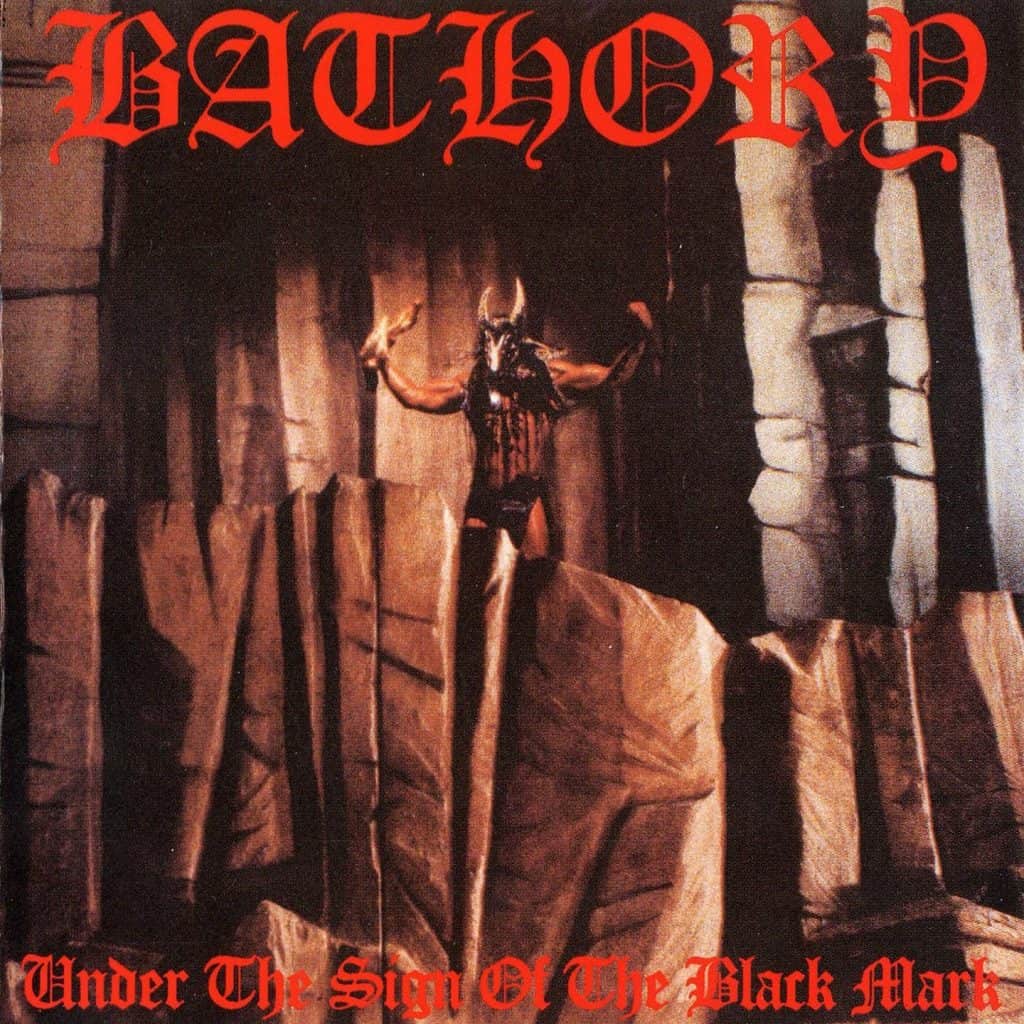
BATHORY – Under the Sign of the Black Mark (Under One Flag, 1987)
When Mayhem were pushing extremity to the edge with “Deathcrush” searching of what they actually wanted to do, Quorthon was offering his third complete black installment of the Satanic Trilogy that heavily influenced the second wave of black metal.
A true black metal album, even if during its release such a term was not used and you could see Bathory mentioned among thrash metal bands, even speed metal, while there was also an advert mentioning them as “death metal”.
A true game-changer and tracks like “Call from the Grave”, “Enter the Eternal Fire” and “Woman of Dark Desires” set the template for what followed after a few years.
Check also: BATHORY – Bathory (1984), BATHORY – The Return…… (1985), SAMAEL – Worship Him (1991), ANCIENT RITES – The Diabolic Serenades (1994), THE BLACK – The Priest of Satan (1994)
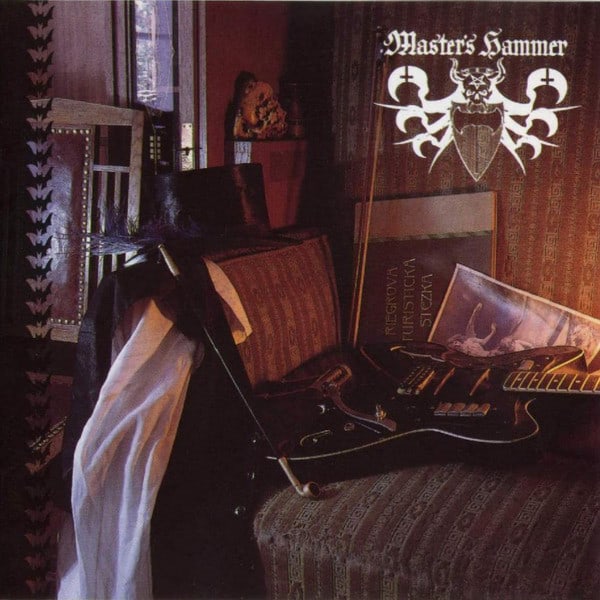
MASTER’S HAMMER – Jilemnický Okultista (Independent, 1992)
Mostly known as “The Jilemnice Occultist” as it was re-released by Osmose a year later (there is also the alternative title of “The Filemnice Occultist”), the second album of Master’s Hammer is a highly influential album for the black metal scene.
The cult band from Czechoslovakia was formed in 1987 while the founder, singer and multi-instrumentalist František Štorm is an artist who also studied in the Academy of Arts, Architecture and Design in Prague.
The term “experimental” has a different meaning nowadays but in the early ’90s, this band was ahead of its time, and this album was mystical and bizarre, using elements that later were called “symphonic” but in a raw way with a spooky atmosphere.
Adding keyboards, synth-generated orchestra sounds and a timpani player as a full band member, the mystique-black-metal of Master’s Hammer was completed as a narrative play, a horror mini-opera.
Check also: ROOT – Zjevení (1990), MASTER’S HAMMER – Ritual. (1991), BEHERIT – Drawing Down the Moon (1993), MORTUARY DRAPE – All the Witches Dance (1994), NECROMASS – Mysteria Mystica Zofiriana (1994)
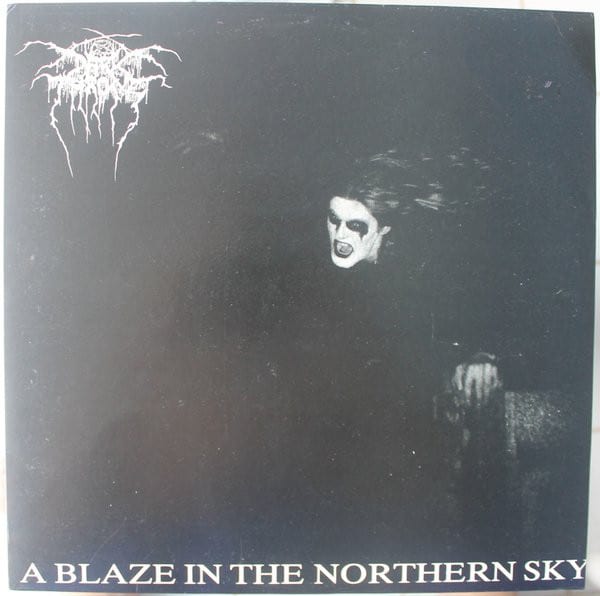
DARKTHRONE – A Blaze in the Northern Sky (Peaceville, 1992)
While after the debut album “Soulside Journey” Darkthrone were rehearsing for “Goatlord”, Nocturno Culto, Fenriz and Zephyrous changed direction (keeping a few of their death metal ideas) releasing this scene-defining black metal masterpiece that truly is a crossover release without any standardized technique, keeping the organic sound of the pre-modern world and the coldness of a new dark era leading to the Norwegian black metal sound we know.
In the next few albums the Norwegian black metal style was finalized and in Darkthrone’s huge discography with the absence of live performances, you can also locate all the influences they allowed to enter in their songs, from punk and AC/DC, to Manilla Road and Agent Steel. Definitely one of the most important black metal bands.
Check also: DARKTHRONE – Under a Funeral Moon (1993), DARKTHRONE – Transilvanian Hunger (1994), CARPATHIAN FOREST – Through Chasm, Caves and Titan Woods (1995), KATHARSIS – 666 (2000), ARMAGEDDA – Only True Believers (2003)
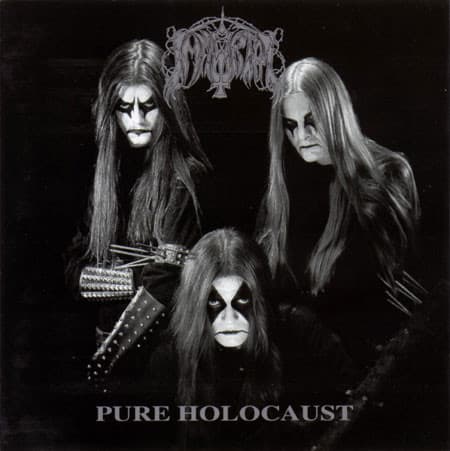
IMMORTAL – Pure Holocaust (Osmose, 1993)
The blackest of black metal is frozen by icewinds and not burnt in Satanic flames. Immortal were never really involved in the religious side despite the pompous title of their debut album “Diabolical Fullmoon Mysticism”.
They were also away from the political ideologies often associated with the Norwegian scene and for a few people they were “false”. Maybe the video for “The Call of the Wintermoon” from their debut album also has something to do with that.
Abbath and Demonaz mostly followed their own path of grimness, evil, the heart of winter and the mystical place of Blashyrkh, where they visualized it in “Battles of the North”. “Pure Holocaust” is the relentless, cold and pure Norwegian black metal album that simplifies all the elements of the genre adding the holocaust-sound courtesy of Demonaz’ guitars.
After the release of “Blizzard Beasts” (1997), Demonaz was diagnosed with acute tendinopathy and could no longer perform guitar duties, so Abbath took care of the guitar parts changing the band’s sound from “At the Heart of Winter” until his departure in 2015.
Check also: IMMORTAL – Diabolical Fullmoon Mysticism (1992), IMMORTAL – Battles in the North (1995), SETHERIAL – Nord… (1996), DARK FUNERAL -The Secrets of the Black Arts (1996), IMMORTAL – At the Heart of Winter (1999)
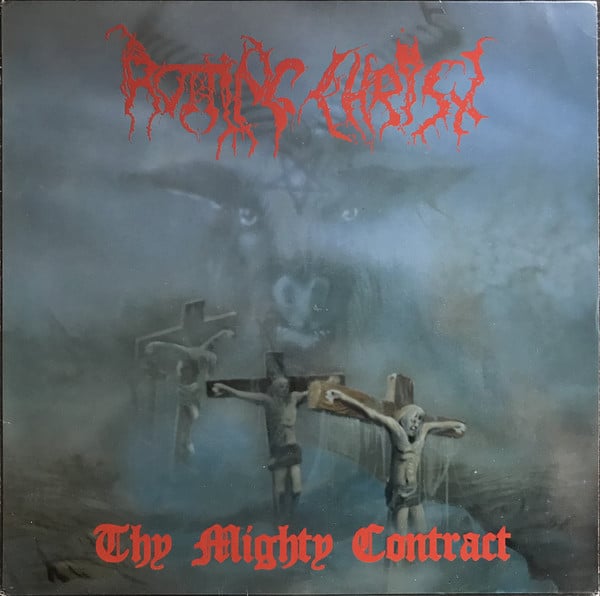
ROTTING CHRIST – Thy Mighty Contract (Osmose, 1993)
After the early demo and EP years, the time had come for Rotting Christ to record the debut album, an album that set new standards in the black metal scene; the archetypal Hellenic black metal sound. Based on actual riffing and not the tremolo-picking Norwegian black metal riffing style, it has a more “classic” metal and melodic approach.
Most of the lyrics don’t really make sense but they have a really weird and mystical aura, while the keyboards add more mystical atmosphere. That album was welcome with owe from the worldwide underground metal scene, including musicians from bands in different kinds of metal, like the leading members of Moonspell, Behemoth, Primordial, Watain, etc.
Unlike other bands, this was just the beginning for Rotting Christ that became a leading force in the worldwide black metal scene and many more great albums followed.
Check also: NECROMANTIA/VARATHRON – The Black Arts/The Everlasting Sins (1992), VARATHRON – His Majesty at the Swamp (1993), ROTTING CHRIST – Non Serviam (1994), THOU ART LORD – Eosforos (1994), AGATUS – Dawn of Martyrdom (1996)
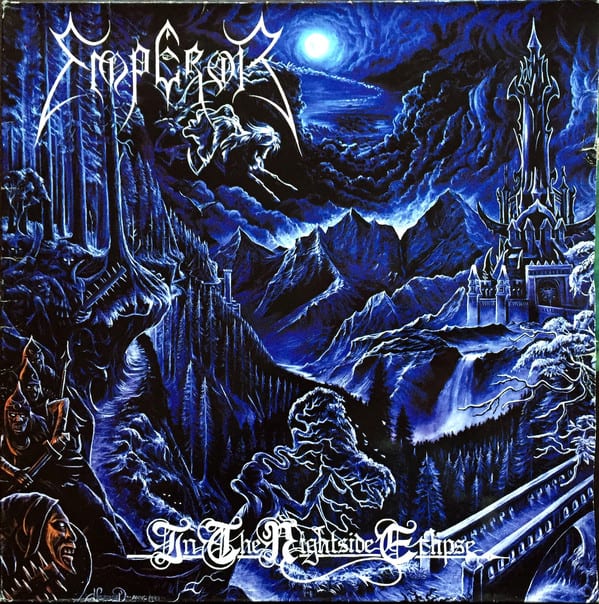
EMPEROR – In the Nightside Eclipse (Candlelight, 1994)
“I wrote most of that album in the cellar of Euronymous’ shop”, Ihsahn said to Ciaran Tracey in an interview for Terrorizer magazine and we can’t ignore the impact Øystein had on the 18-year old then Ihsahn but what Ihsahn (vocals, guitars, keyboards), Samoth (guitars), Tchort (bass) and Faust (drums) did with “In the Nightside Eclipse” is probably beyond any expectation.
However, when the album was released in the midst of the EVENTS, all members except Ihsahn ended in prison (Faust for murder, Samoth for arson and Tchort for assault) so the next album “Anthems to the Welkin at Dusk” was finally released three years later and only Samoth returned to the line-up, with Emperor paying tribute to Euronymous using one of his riffs from an unreleased track as the opening of “Ye Entrancemperium”.
And while it is very often debated which one of the Emperor albums is “better” this is not the case. Having a more “epic” (see “majestic”) approach and better musicianship than most of the other black metal bands, Emperor were ambitious and Ihsahn always knew what he could do.
And what Emperor actually did, is to set new standards in black metal songwriting and performance, with atmosphere, guitars and riffing to die for.
Check also: GEHENNA – Seen Through the Veils of Darkness (The Second Spell) (1995), GEHENNA – Malice (Our Third Spell) (1996), LIMBONIC ART – Moon in the Scorpio (1996), EMPEROR – Anthems to the Welkin at Dusk (1997), EMPEROR – IX Equilibrium (1999)
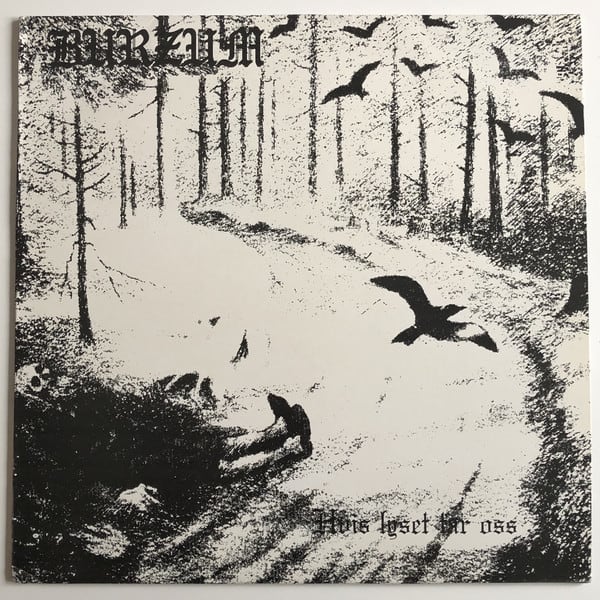
BURZUM – Hvis Lyset Tar Oss (Misanthropy Records, 1994)
The 14-minute opening track “Det som en gang var” is one of the best songs of the second wave of black metal and the 14-minute closing track “Tomhet” is the ambient song that influenced the future.
The album was recorded in Grieghallen Studio in 1992 and was released a few days before the beginning of the trial for the murder of Euronymous. Nearly a month after the album’s release, Varg was sentenced to 21 years in prison and he already had one more album recorded in 1993 (“Filosofem”, often stated as Count’s best album) that was released in 1996, like he knew what was going to happen.
Varg is among the very few people that gave birth to black metal as we know it and at the same time, he is the reason why many people loathe the genre nowadays, even if a few of them were, or are part of it. There is the usual lo-fi production of the early Burzum albums and a lack of complexity but many people were already mentioning Varg’s skills, among them producer Pytten and drummer Hellhammer.
Dedicated to his friend Fenriz, “Hvis lyset tar oss” is a concept album and the translated titles of the four songs are the exact meaning of it: What Once Was, If the Light Takes Us, Into the Castle from the Dream, Emptiness.
This hypnotic and monotonous album is also the beginning of atmospheric black metal, the end of an era and the beginning of a new evil world.
Check also: BURZUM – Filosofem (1996), MOONBLOOD – Blut & Krieg (1997), DRUDKH – Forgotten Legends (2003), NOCTERNITY – Onyx (2003), BURZUM – Fallen (2011)
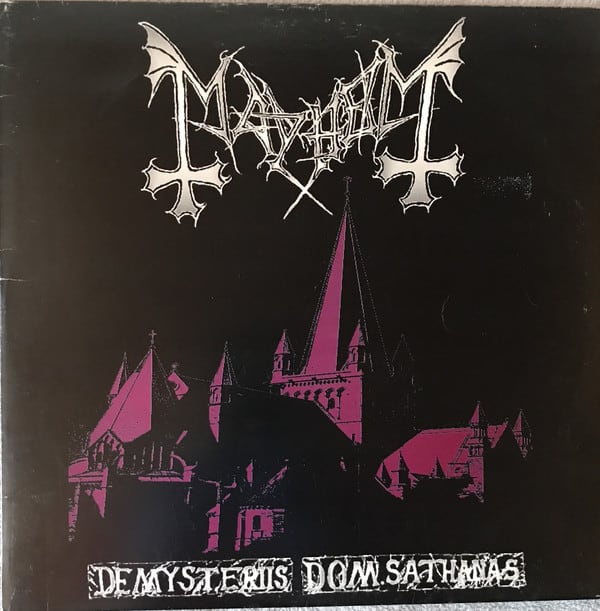
MAYHEM – De Mysteriis Dom. Sathanas (Deathlike Silence, 1994)
Upon its release, many things were confusing. Did Hellhammer re-recorded Varg’s bass parts as he promised to Øystein’s parents? Who were the actual members that recorded the album? Who wrote the music?Who wrote the lyrics? These were questions my 17-old then self had in mind when the album-to-end-all-albums was released. When it was finally out most of the people were frozen and didn’t know how to react.
There were people in the black metal community back then who believed that Attila destroyed the album with his vocals and it would be better with Dead. No disrespect to Dead but Attila is THE voice of the mysteriis.
And even if it sounds “old-school” nowadays, it was a “futuristic” release in 1994 with a massive production (especially the drums) for the genre, created by hard work and talent, the past and a look to the future, darkness and blood.
Just like most of the masterpieces of metal music, they’re reaching that status after a few years but everyone knew that this was THE album when it was unleashed upon the world. It took no long. This is the greatest Black Metal album ever recorded. Would it be the same if Euronymous wasn’t murdered by Varg and the events of that era? Definitely!
Check also: MARDUK – Opus Nocturne (1994), GORGOROTH – Pentagram (1994), GORGOROTH – Antichrist (1996), GORGOROTH – Under the Sign of Hell (1997), MARDUK – Panzer Division Marduk (1999)
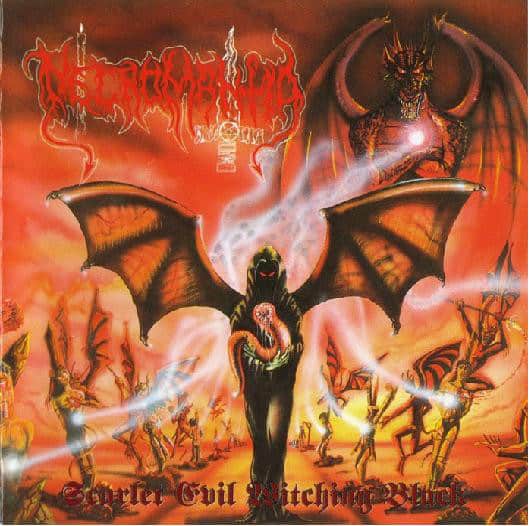
NECROMANTIA – Scarlet Evil Witching Black (Osmose, 1995)
The second full-length album of Necromantia is a unique piece of black metal art. There are 4- and 8-string bass guitars, synths, even saxophone but not rhythm guitars and yet, it has an unmatchable evil atmosphere.
While in the Norwegian scene there was a very strong early-Bathory influence, Necromantia add the evil elements of early-Manowar and a variety of obscure soundscapes of the pre-internet era, offering a sinister and vampiric album, while Magus Wampyr Daoloth claims to be a member of Anton LaVey’s Church of Satan and also Temple of the Vampire, making the “satanic” and mystical element more true and deep.
Check also: NECROMANTIA – Crossing the Fiery Path (1993), IMPALED NAZARENE – Ugra-Karma (1993), MÜTIILATION – Vampires of Black Imperial Blood (1995), ZEMIAL – For the Glory of UR (1996), AGATUS – The Weaving Fates (2002)
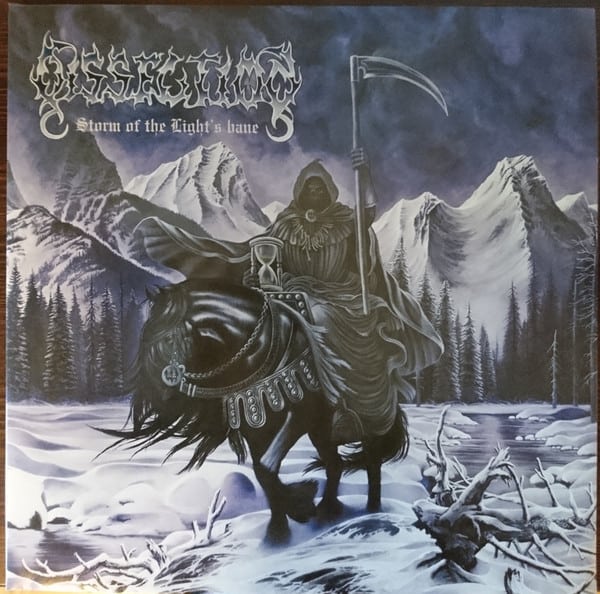
DISSECTION – Storm of the Light’s Bane (Nuclear Blast, 1995)
Jon Nödtveidt’s 31 years in the mortal world won’t be easily forgotten. “Storm of the Light’s Bane” was released when the Misanthropic Luciferian Order was formed, which later changed name to Temple of the Black Light, and Nödtveidt was a member of.
Dissection’s sophomore album is the best example of melodic black metal (having also death metal elements) with a perfect production, intense and briliant guitar work with majestic harmonies and a trully convincing satanic performance.
Jon was only 20 years when this album was released. This is not a “cheesy satanic” album, this is as true as it gets. Jon Nödtveidt was convicted of being an accessory to murder, in the killing of a homosexual Algerian in 1997 and he was released from prison in 2004.
Two years later, he was found dead in his apartment inside a circle of lit candles. As a true Satanist who fullfiled his destiny, he decided to end his own life reaching his peak in life and wandering “where dead angels lie” since then.
Check also: DISSECTION – The Somberlain (1993), NAGLFAR – Vittra (1995), WATAIN – Casus Luciferi (2003), WATAIN – Sworn to the Dark (2007), WATAIN – Lawless Darkness (2010)
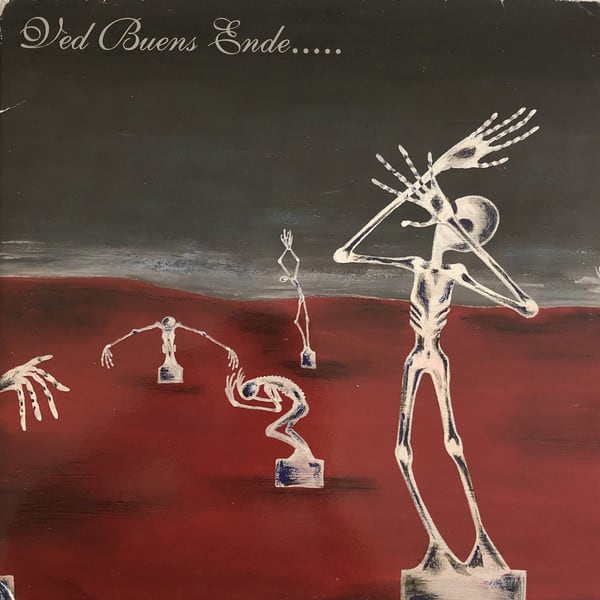
VED BUENS ENDE – Written in Waters (Misanthropy, 1995)
The fame of this album was built over the years. Didn’t take long but upon its release I don’t remember it taking the credit it deserved, lost under the weight of all those great black metal albums that were released in 1995 and the band was split after a while.
Vicotnik, Skoll and Aggressor have a very wide “portfolio” of bands they participated in during their life. However, in the only full-length album of the entity named Ved Buens Ende, they break all boundaries and at the same time, they combine elements from all of them, giving life to a strange and hypnotic album, one of the first that proved black metal can create pure and uncategorized art.
For a few in the beginning, for all those who wanted diversity in the future since this outsider then, was one of the first albums that now we use to call “avant-garde metal”, even “post black metal”. Definitely ahead of its time.
Check also: IN THE WOODS… – Heart of the Ages (1995), FLEURETY – Min tid skal komme (1995), IN THE WOODS… – Omnio (1997), ULVER – Themes from William Blake’s The Marriage of Heaven and Hell (1998), VIRUS – Carheart (2003)
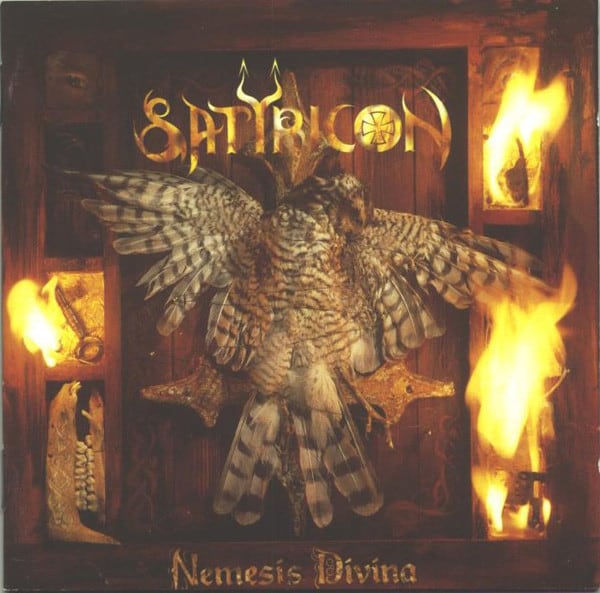
SATYRICON – Nemesis Divina (Moonfog, 1996)
While Satyricon have been evolved to a controversial band, none can really ignore the fact that “Nemesis Divina” is one of the best Norwegian black metal albums.
Truth to be told, you don’t see them very often mentioned among the greatest bands of the genre but if we will talk about albums and someone will mention “Nemesis Divina”, it has to be among the greatest albums of the genre.
A colourful album with atmosphere, rawness, epicness, confidence and maturity. The three opening tracks “The Dawn of a New Age”, “Forhekset”, and “Mother North” are the showcase of ’90s black metal brilliance. Magnificent songwriting and performance and while Satyr is a very talented multi-instrumentalist, drummer Frost is also one in the top of his game.
Nocturno Culto of Darkthrone helped with rhythm guitars while in the early rehearsals there was also Ihsahn of Emperor helping with keyboards parts. By 1996, Norwegian black metal had already offered groundbreaking masterpieces that had also an impact outside the scene proving how important was black metal for the ’90s.
Check also: SATYRICON – Dark Medieval Times (1994), SATYRICON – The Shadowthrone (1994), ABIGOR – Nachthymnen (From the Twilight Kingdom) (1995), BLUT AUS NORD – Memoria Vetusta I: Fathers of the Icy Age (1996), DARKTHRONE – Ravishing Grimness (1999)
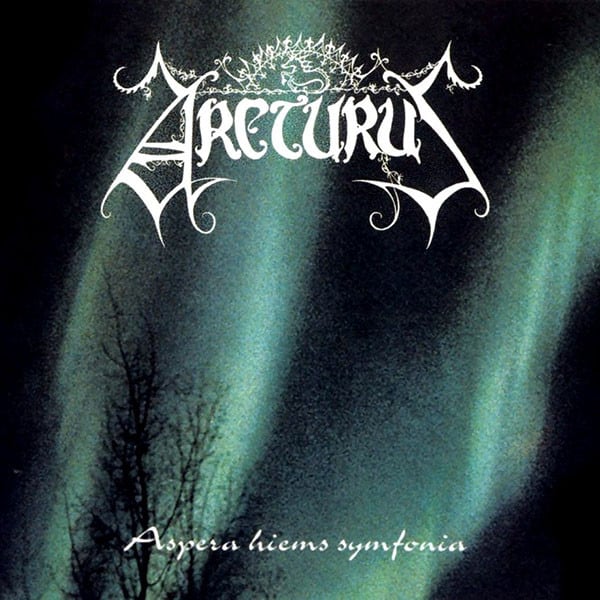
ARCTURUS – Aspera Hiems Symfonia (Ancient Lore Creations, 1996)
When Mortem were somehow in hiatus, Arcturus appeared. Not exactly as a continuation but mostly as a different entity. With the line-up of mastermind Sverd (keyboards), Hellhammer (drums), August (guitars) and Garm (vocals), the first full-length album of the band is a majestic avant-garde black metal offering that paved the way to a different and brave future, proving that black metal is the futuristic genre of invention and diversity in the ’90s.
Sverd’s synths and keyboards built a unique symphonic atmosphere and what was named as “symphonic metal” (the debut album of Nightwish was released a year later) owes a huge part to Arcturus. Hellhammer proves again that he is one of the greatest metal drummers and Garm’s vocals are among the best ones of the Norwegian black metal scene, changing many different voices in this bizarre carnival of unsettling soundscapes.
August (born Carl August Tidemann) is a magnificent progressive and neoclassical guitar player, something that was more obvious in Winds and albums like “Reflections of the I” (2002) where Hellhammer also played drums proving once again his unmatchable talent.
Still though, the next Arcturus album is another strong influence even for bands like Winds with its avant-garde progressive metal aura beyond any musical limit that for many is their magnum opus.
Check also: ARCTURUS – La Masquerade Infernale (1997), SOLEFALD – The Linear Scaffold (1997), SIGH – Hail Horror Hail (1997), SOLEFALD – Neonism (1999), NEGURA BUNGET – ‘n crugu bradului (2002)
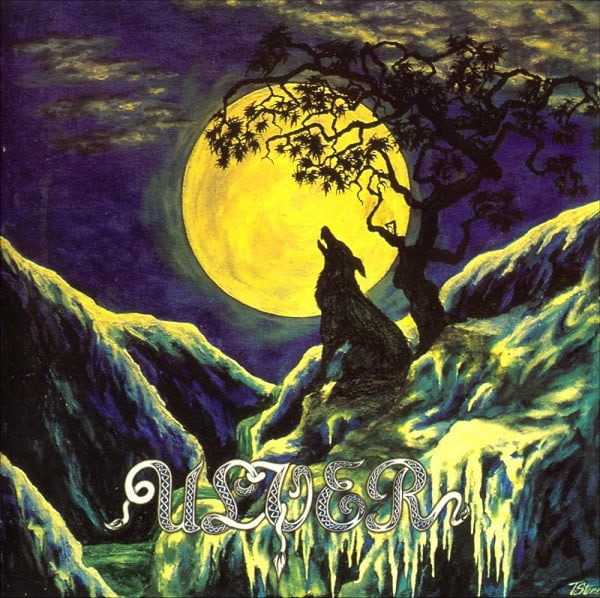
ULVER – Nattens Madrigal – Aatte Hymne Til Ulven I Manden (Century Media, 1997)
Ulver had a strong vision of their art from the very beginning. Just like Burzum, their early albums (the Black Metal Trilogie) were not influenced by Satanism but by Norwegian folklore and fairytales.
Just a few months after the release of their debut album “Bergtatt”, they were already mentioning “Nattens Madrigal” and the concept of lycanthropy, even if their second album “Kveldssanger” (1996) wasn’t even released.
Adding further detail, they were already using quotes of William Blake, years before the release of the ambitious “Themes from William Blake’s The Marriage of Heaven and Hell”. So Ulver were always using lyrics to guide their music since the beginning.
And while back then they were talking in interviews about the “Norwegian elite” of black metal admiring Darkthrone, it didn’t take but a few months for those “wolves” to follow a different path of music experimentation. Still though, the early albums are rated very high in the Norwegian black metal scene and singer Garm (Kristoffer Rygg) was already exploring different paths with Arcturus.
The lo-fi underproduced recording of “Nattens Madrigal”, composed in 1995, recorded in 1996 and released in 1997, didn’t lack myths and weird stories but in reality, it made Garm leave behind him the primitive black metal for good.
Check also: ENSLAVED – Vikingligr Veldi (1994), ULVER – Bergtatt – Et Eeventyr I 5 Capitler (1995), ULVER – Kveldssanger (1996), BORKNAGAR – Borknagar (1996), MANES – Under Ein Blodraud Maane (1999)
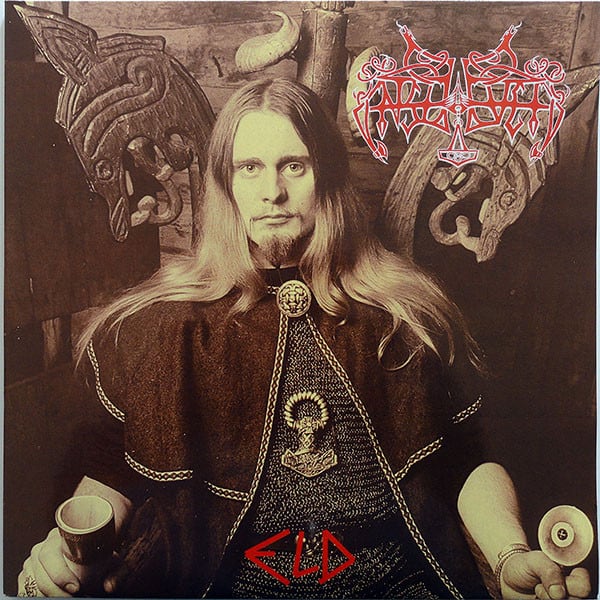
ENSLAVED – Eld (Osmose, 1997)
While Enslaved have been moved to a wider progressive metal sound, they didn’t feel very kin with the “black metal” label since the early albums.
The 16-minute opening track “793 (Slaget om Lindisfarne)” is a standout viking metal opus but during the rest of the tracks, you have the black metal blast and ferocious riffing of the era despite the absence of the satanic lyrical content.
The primeval atmosphere of “Eld” is captivating, black metal was already rapidly evolving and that was magical.
Check also: SUMMONING – Minas Morgul (1995), BORKNAGAR – The Olden Domain (1997), MOONSORROW – Verisäkeet (2005), ZEMIAL – In Monumentum (2006), MACABRE OMEN – Gods of War – At War (2015)
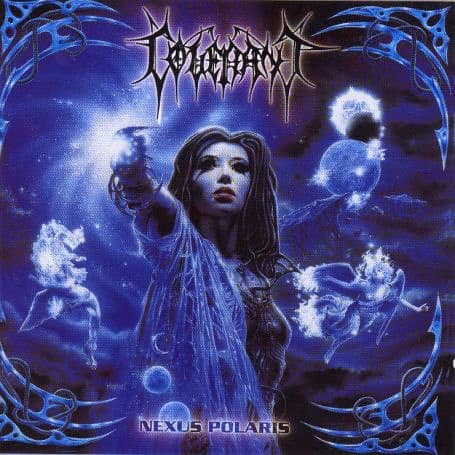
COVENANT – Nexus Polaris (Nuclear Blast, 1998)
Nagash and Blackheart surely had a vision of a bizarre cosmic black metal and when the right people joined the chariot of fire, the path revealed. The rest of the theatricons were Astennu (of Carpe Tenebrum) on guitars, Sverd (of Arcturus) on keyboards/synthesizers, Hellhammer (of Mayhem) on drums, and also Sara Jezebel Deva on vocals/starsong, known for guest vocals in Cradle of Filth.
“Nexus Polaris” is an album that many people who are not really into black metal use to like. On the other hand, this is probably an album that Euronymous would loathe if he would still be alive.
This cosmic opera has black metal blast-beats, genuine synth harmonies and keyboards, a few power metal elements, many layers and a huge production. At the same time, Nuclear Blast also released the album of Mundanus Imperium “The Spectral Spheres Coronation” but this “astral-metal-style” didn’t last.
Due to legal issues Covenant changed name to The Kovenant but also changed direction to electronic and industrial music, while the other “cosmic metal” release of 1998 (of Mundanus Imperium) introduced the Norwegian heavy metal singer Jørn Lande to the world who later released albums with Ark, Masterplan and solo, even joined by Hellhammer at “Worldchanger” (2001).
Check also: BAL-SAGOTH – Starfire Burning upon the Ice-Veiled Throne of Ultima Thule (1996), DIMMU BORGIR – Enthrone Darkness Triumphant (1997), LIMBONIC ART – In Abhorrence Dementia (1997), CARACH ANGREN – Where the Corpses Sink Forever (2012), CREATURE – Ex Cathedra (2020)
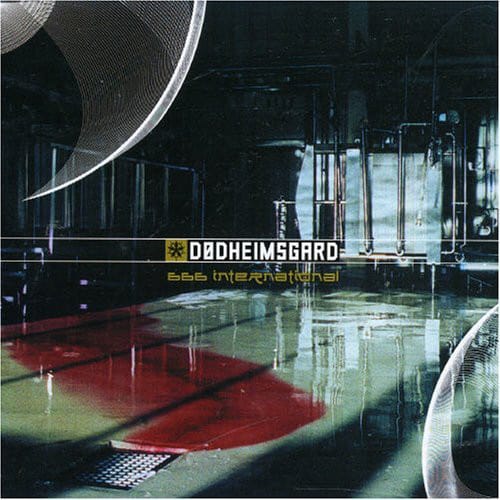
DØDHEIMSGARD – 666 International (Moonfog, 1999)
The ultimate decomposition of normality is important in inspiring musicians to think and compose music outside the stylistic confines of their genre.
This is “666 International”, a surreal album, a cold and experimental manifesto of sickness and weirdness. While people were waiting for the debut album of Thorns, the millennium ended with a glimpse to the chaotic future. A turning point for black metal…
Check also: MYSTICUM – In the Streams of Inferno (1996), <CODE> – Nouveau Gloaming (2005), DØDHEIMSGARD (DHG) – Supervillain Outcast (2007), <CODE> – Resplendent Grotesque (2009), ORANSSI PAZUZU – Värähtelijä (2016)
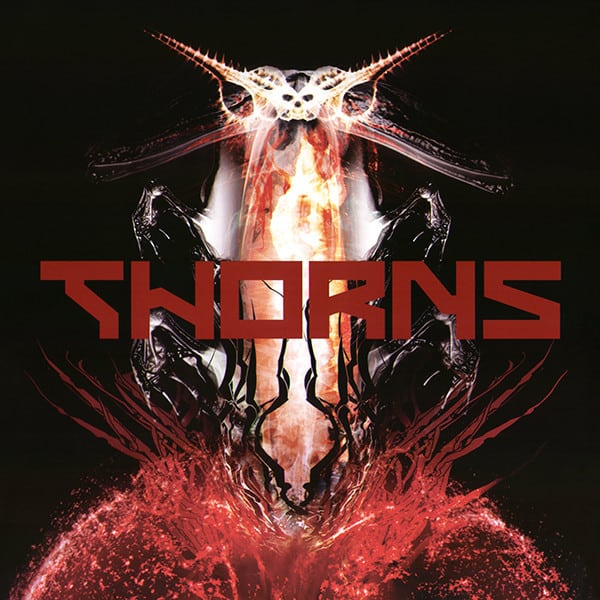
THORNS – Thorns (Moonfog, 2001)
…and then Snorre Ruch returned. There are a few extraordinary guests in “Thorns”, the elite of Norwegian black metal that we won’t mention by names because it doesn’t matter for THIS album.
This album was destined to be phenomenal, a futuristic mechanical black metal album that’s industrial and yet organic, like a cyborg demon that turns the spirals of existence for the interface to God.
This was the future.
Check also: SAMAEL – Ceremony of Opposites (1994), SATYRICON – Rebel Extravaganza (1999), MAYHEM – Grand Declaration of War (2000), ZYKLON – World ov Worms (2001), ABORYM – With No Human Intervention (2003)
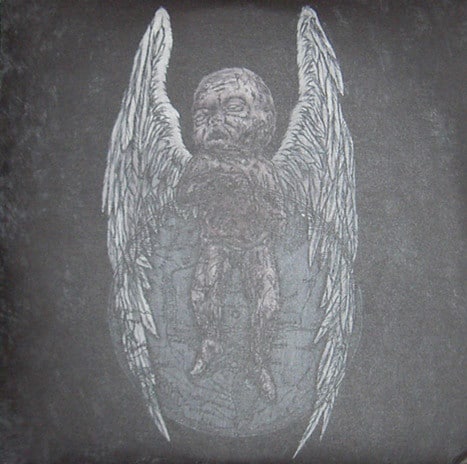
DEATHSPELL OMEGA – Si Monvmentvm Reqvires, Circvmspice (Norma Evangelium Diaboli, 2004)
If Dødheimsgard’s “666 International” is an album that changed the black metal ground forever, the third album of Deathspell Omega from France is the new breath in the genre that brought back the feelings and atmosphere of pure black metal.
From the haunting beginning of “First Prayer”, this is a nearly metaphysical album and Deathspell Omega “saved” black metal. Those eyes have witnessed. Those eyes were deceived. Those eyes have sinned. Those eyes lied zealously. Those eyes were blind. Those eyes saw wisdom.
Check also: AETERNUS – Beyond the Wandering Moon (1997), AETERNUS – …and So the Night Became (1998), DEATHSPELL OMEGA – Fas – Ite, Maledicti, in Ignem Aeternum (2007), BLUT AUS NORD – Memoria Vetusta II: Dialogue with the Stars (2009), FUNERAL MIST – Maranatha (2009)
Epilogue: The Future of Black Metal
Black Metal is dead {and resurrected}. The new entity is different. Maybe there are more entities. Maybe black metal is like the Lernaean Hydra. When Varg Vikernes stabbed to death Euronymous, he cut black metal’s head but the monster regrow two heads for each one cut.
And there were many “cuts” in the ’90s so black metal has evolved to something different. Or diverse if you prefer.
Euronymous, the leading figure of the Norwegian Black Metal scene, was an extremely knowledgeable person with a collection of records from Bathory to Pink Floyd and Tangerine Dream, and many more diverse and experimental albums, something very uncommon for a metalhead in the ’80s.
Euronymous seemed like a person that always wanted to push things to the edge, including also music and influences, besides ideas and acts. By early ’90s, more musicians of the “Inner Circle” were turned to other musical paths, including Varg Vikernes who was also a fan of techno music and also used to visit the clubs.
Again, something very uncommon for metalheads back then, but this is probably what made Black Metal the most diverse metal subgenre.
Bands that released iconic albums of the genre have been evolved to something that has nothing to do with the genre and their past.
Covenant became The Kovenant, Ulver entered the world of electronica, dark wave and synth-pop, even Ihsahn followed a different path, stop releasing albums with Emperor since 2001 and then started his experimental prog-black solo “Ihsahn” career releasing the albums that music journalists praise and the majority of fans ignore.
The extreme ideas are mostly covered or hidden and the heads of the Hydra have many different forms even if the main body is considered “Black Metal”. In the era of social media everything is different and everything can change, including art and music, opinions and ideas, band members and media.
In this new era, every future is mostly unplanned, so close to the goal and yet so far. So far, that the goal and the main idea can change.
The future is unplanned.


[…] And while the author of this blog tried to write the brief story of Black Metal under the title “The Past is Alive: Gazing into the Void of Black Metal” for Vinylom, which date could be considered as the birth of Norwegian Black Metal? That date […]